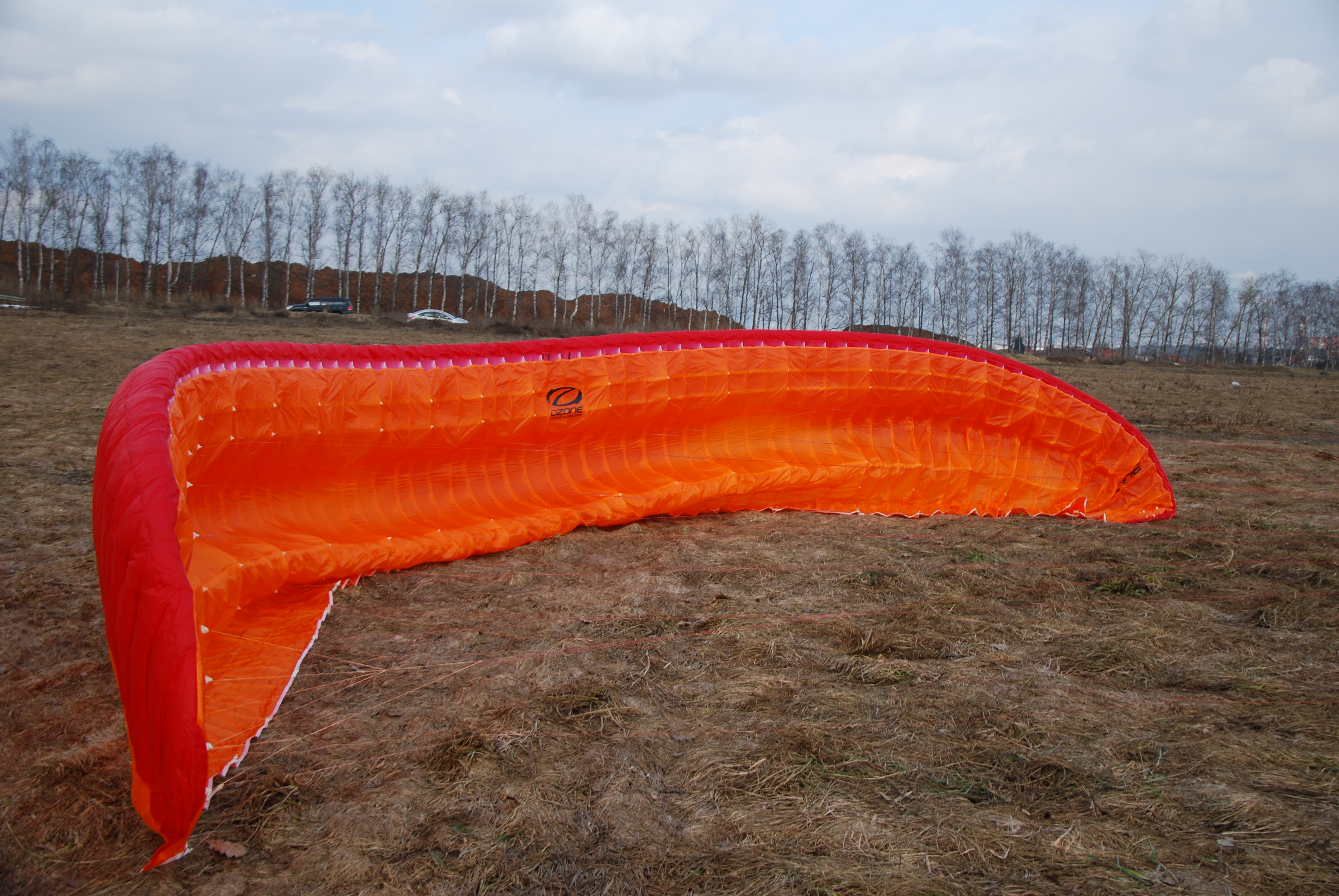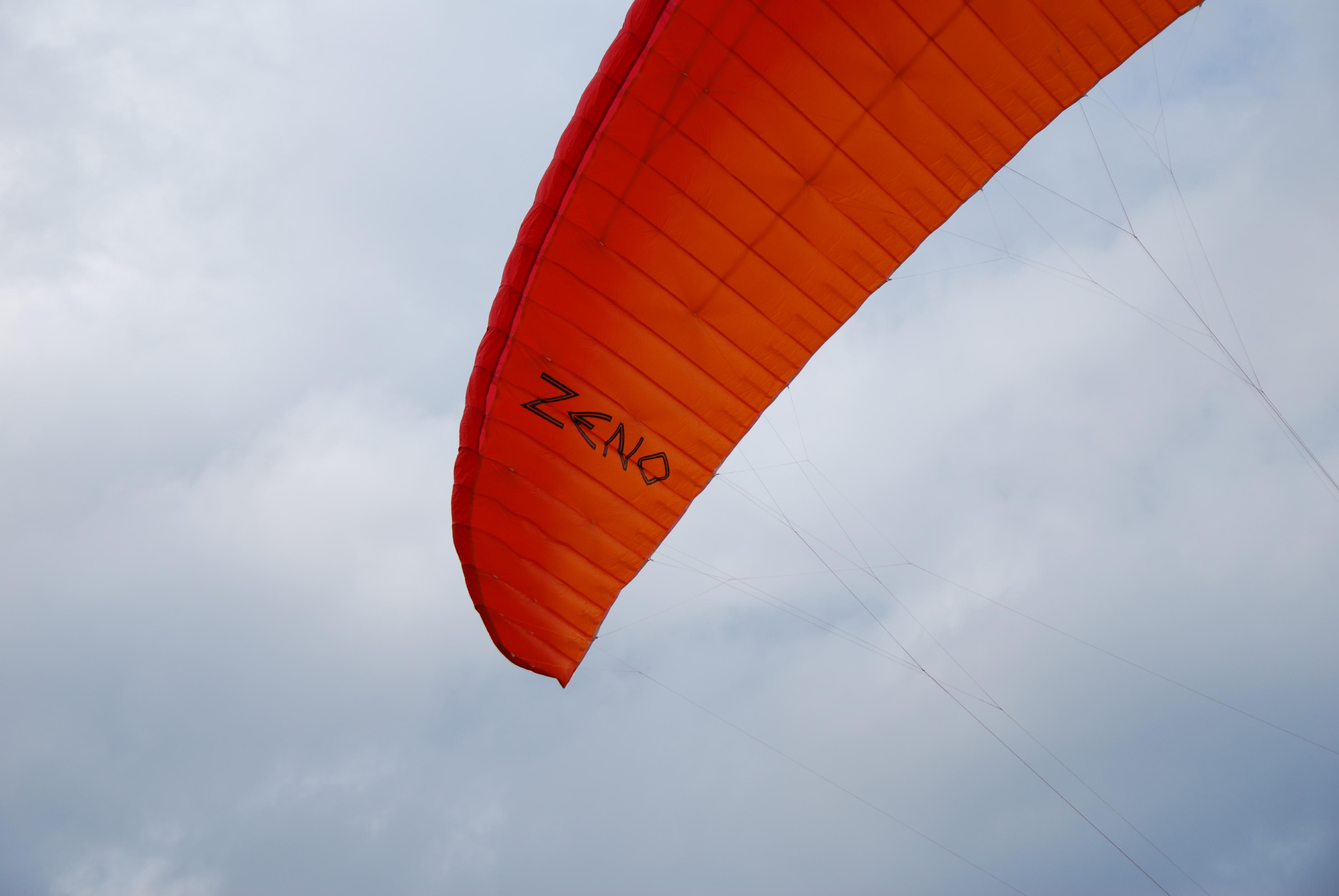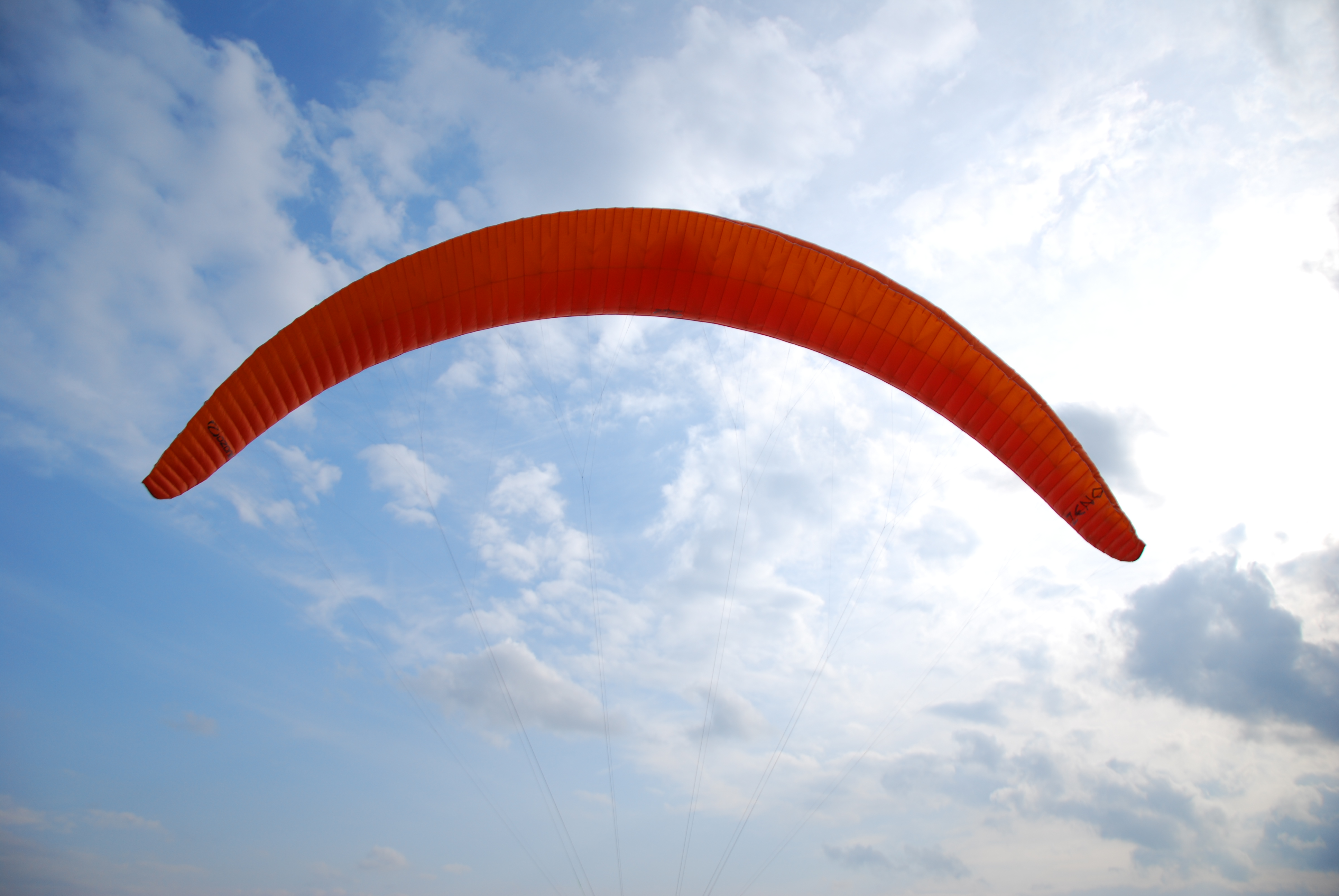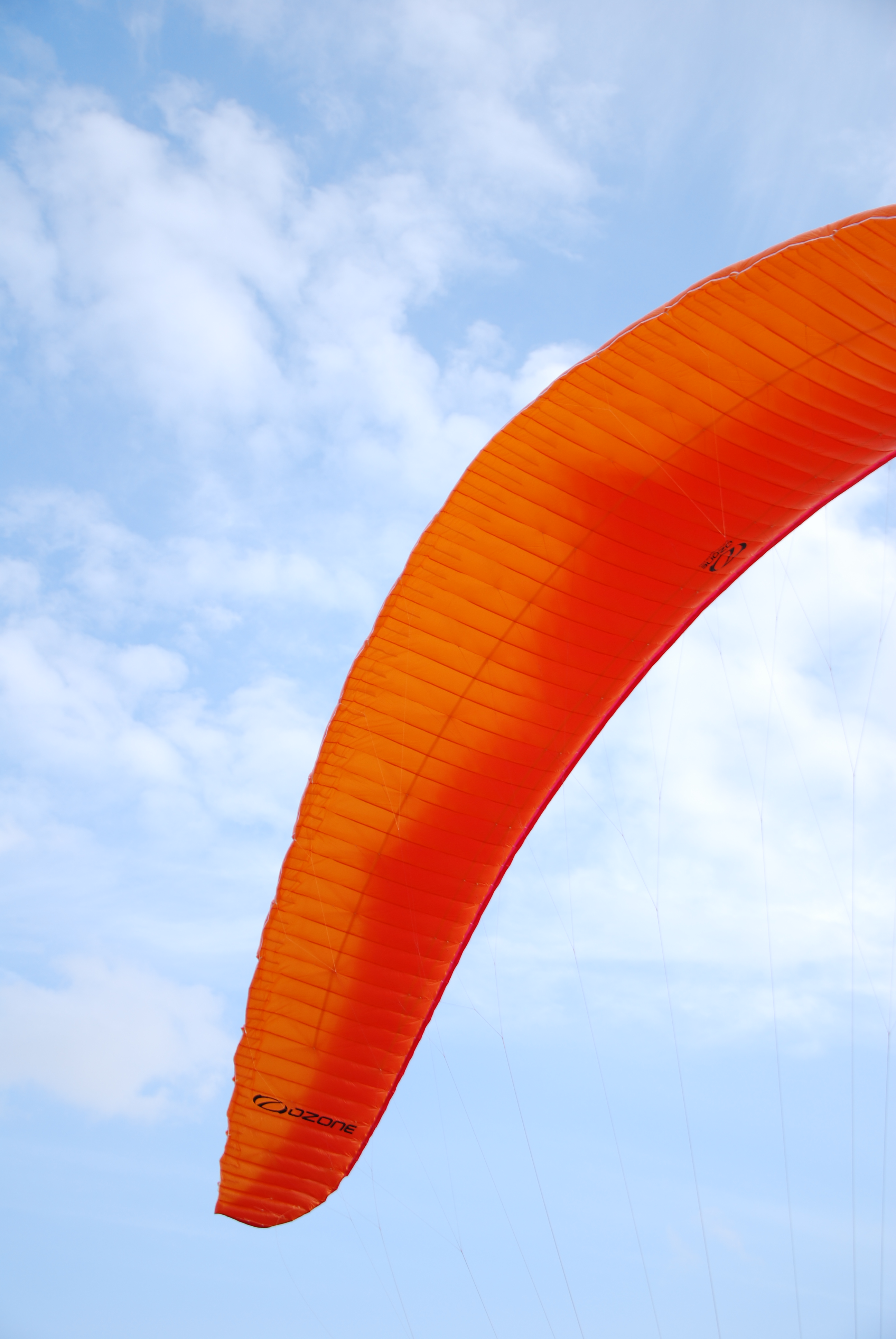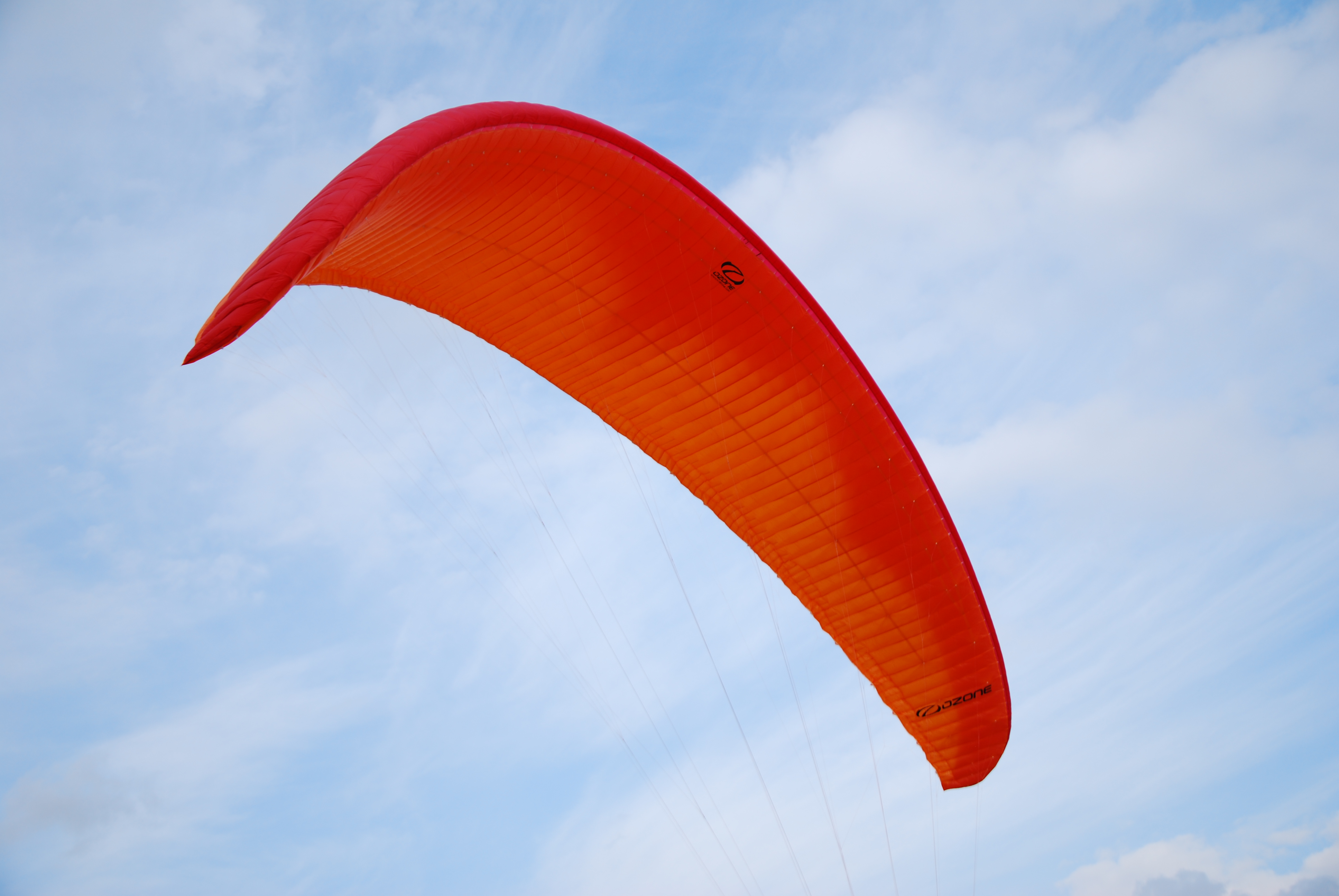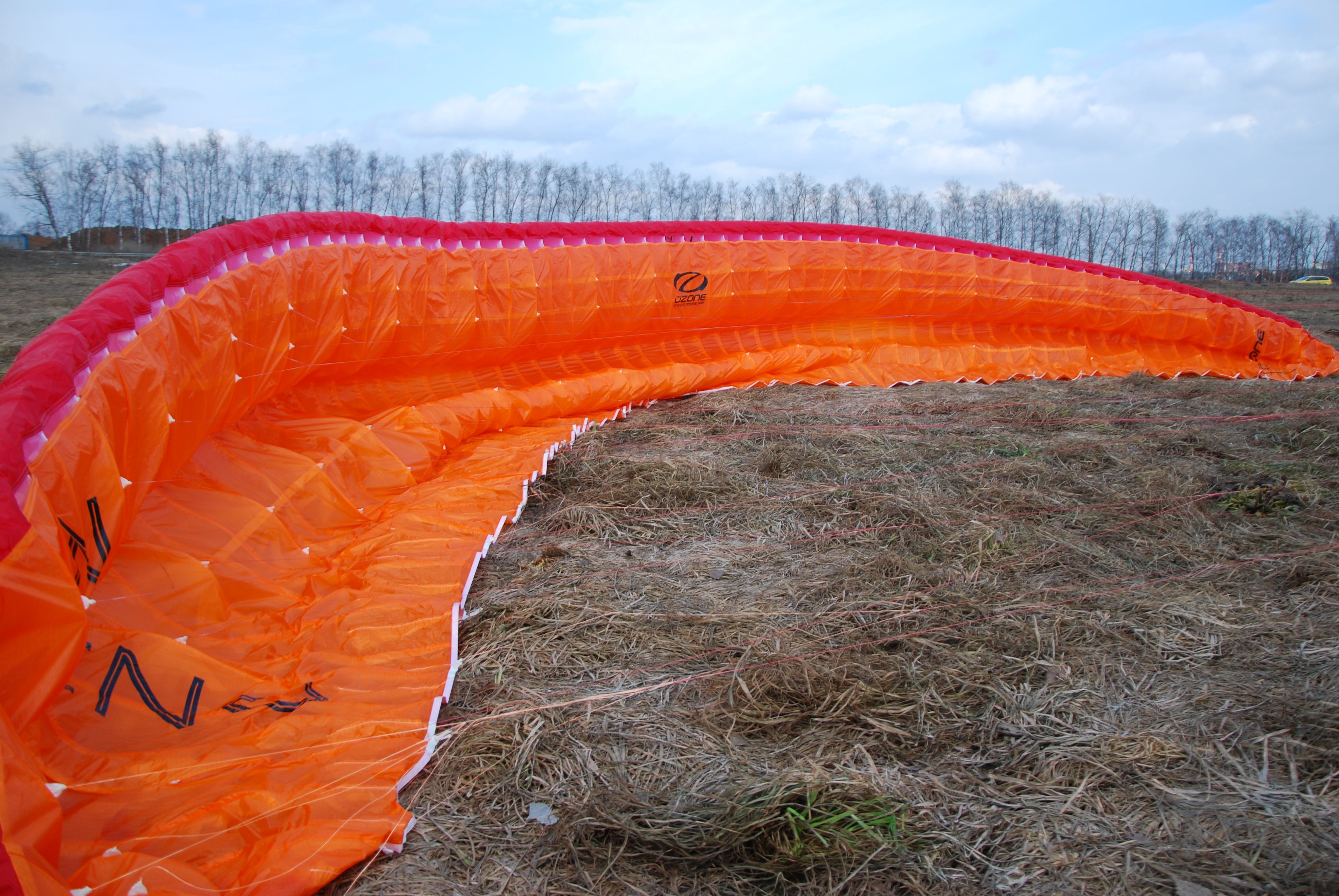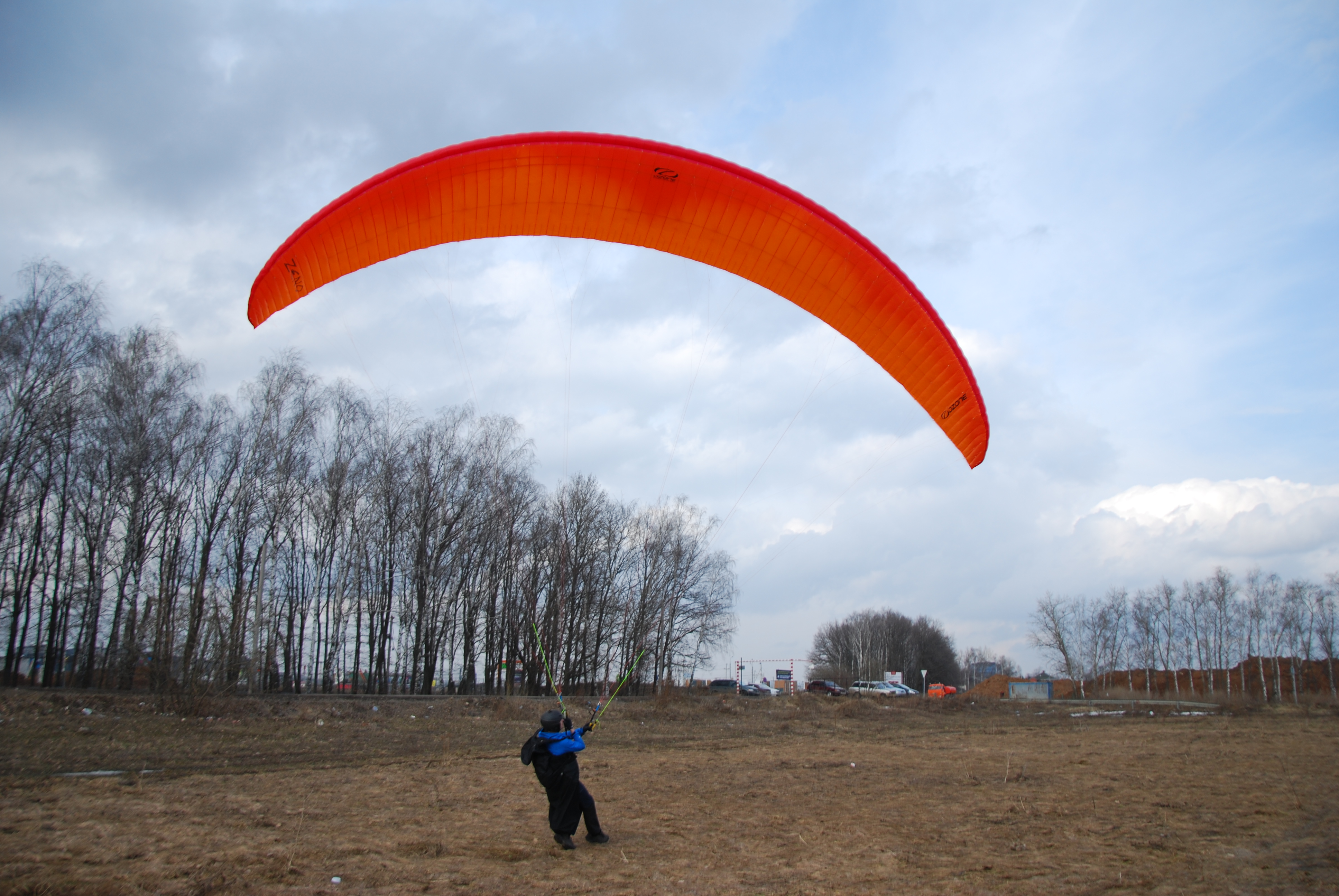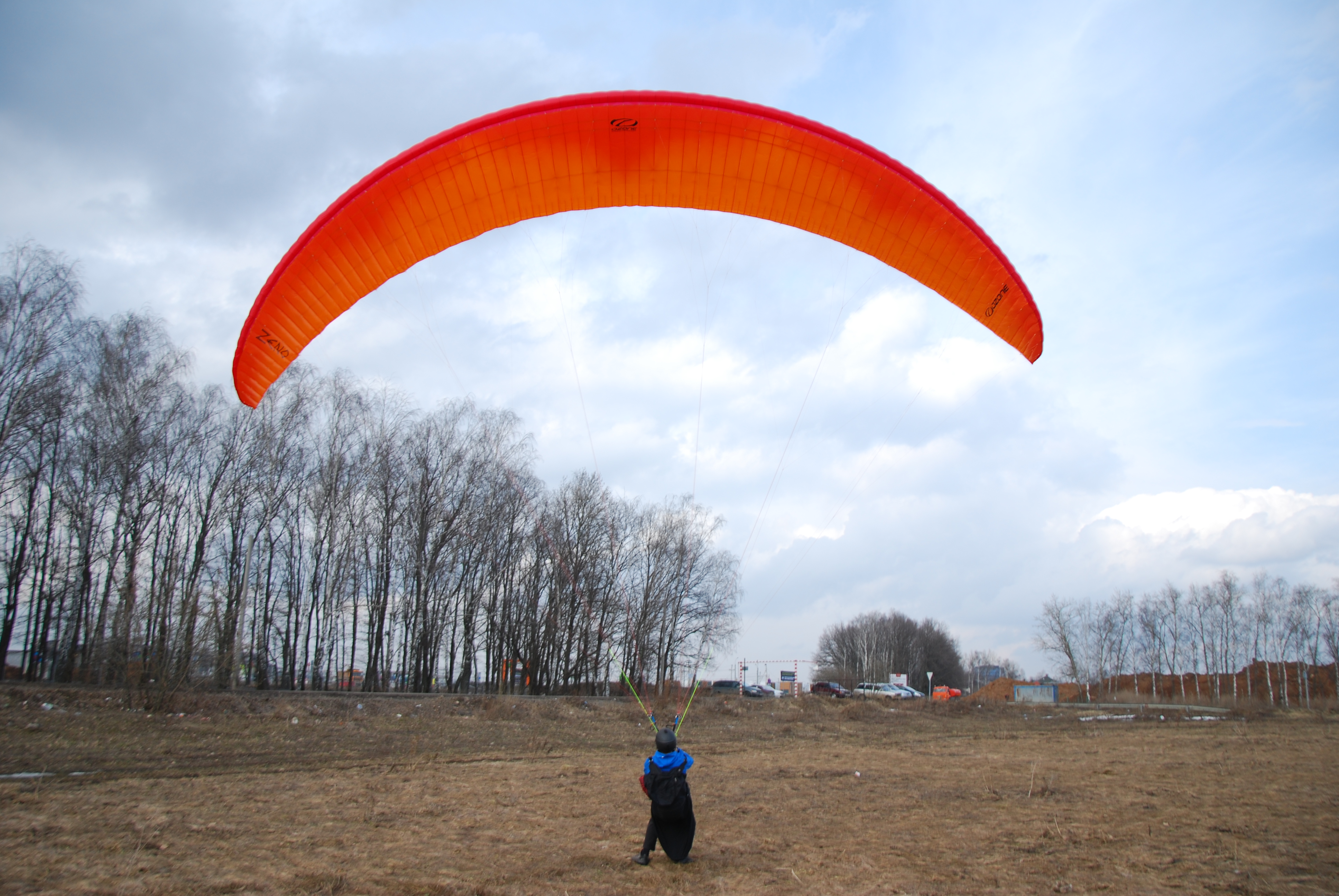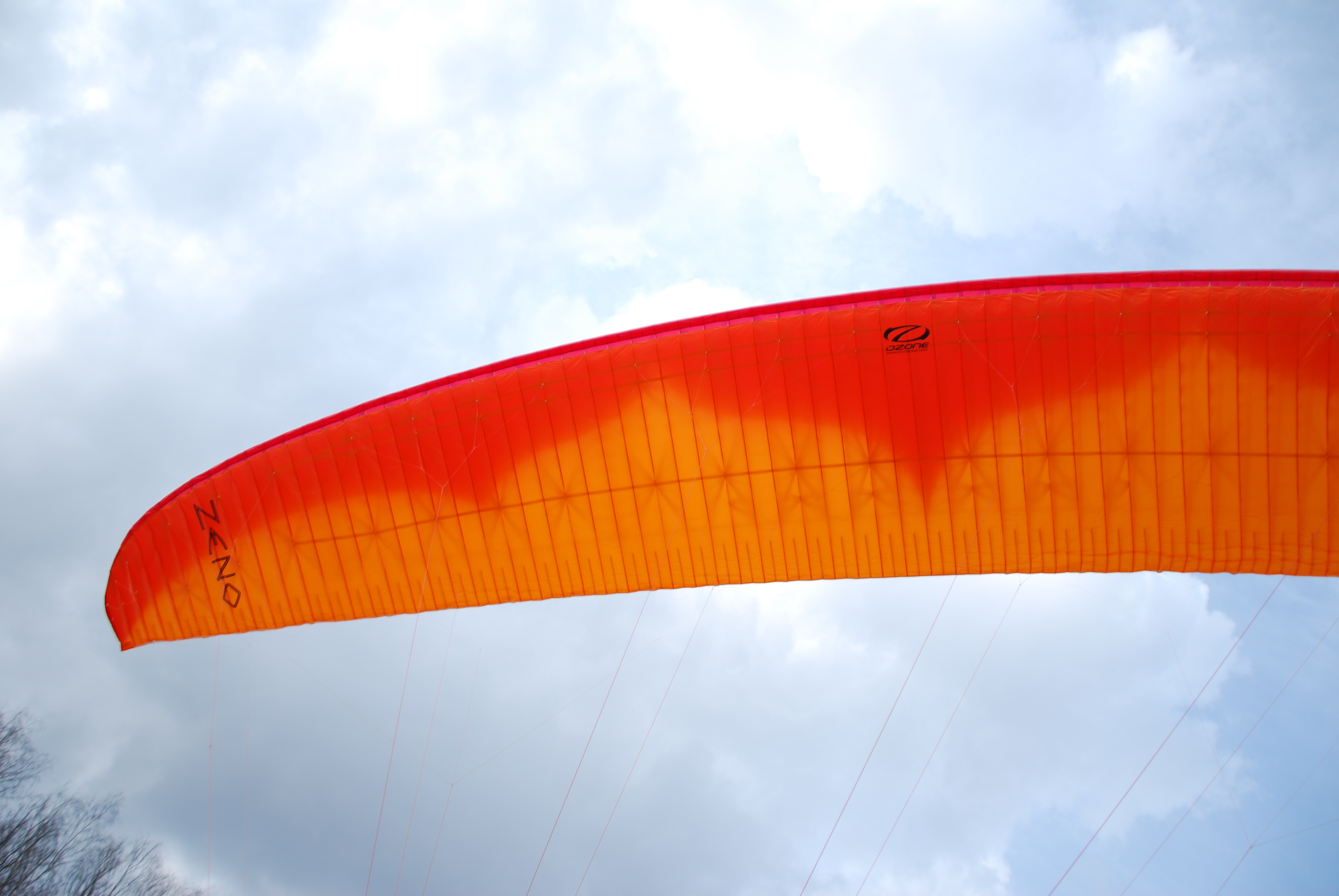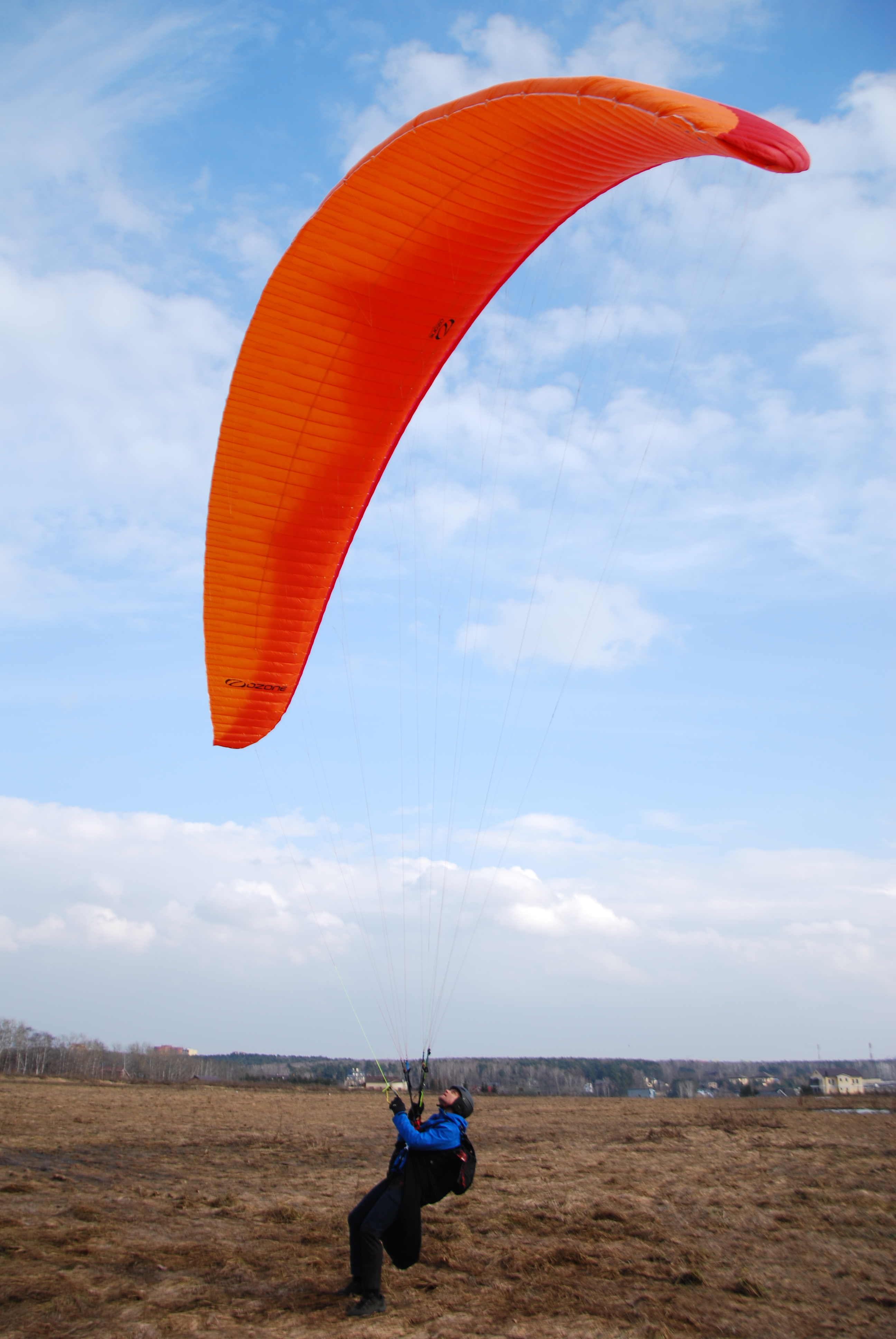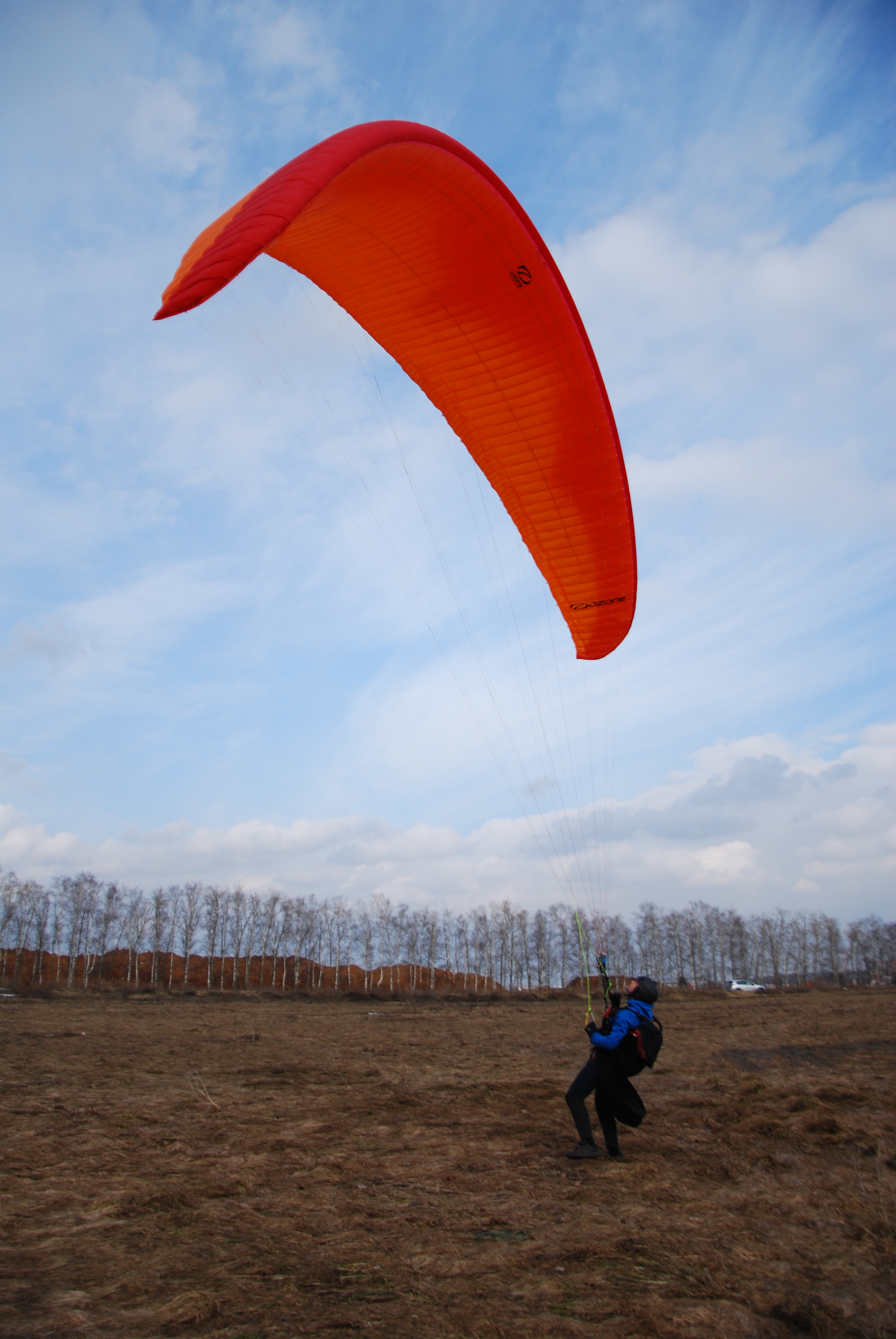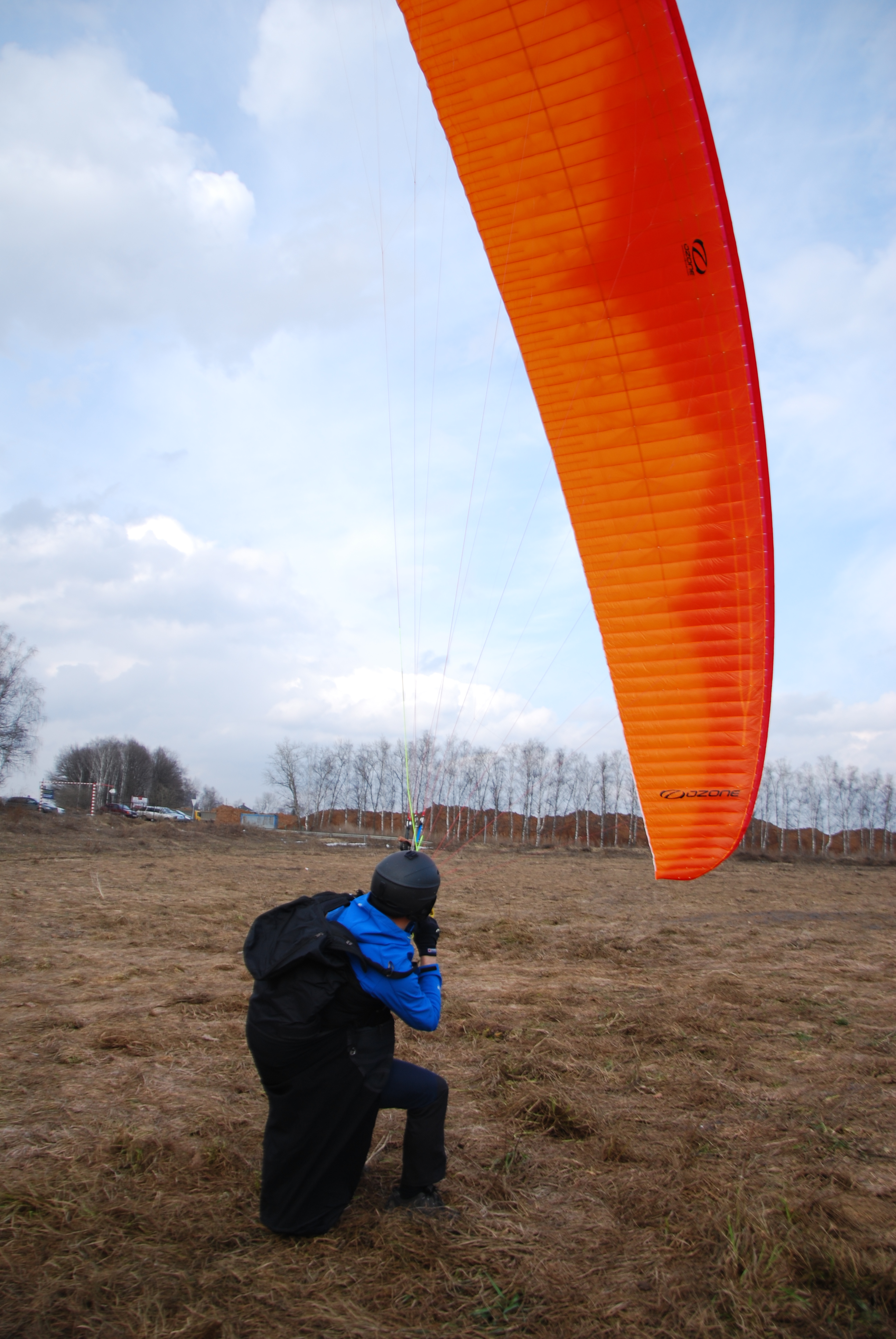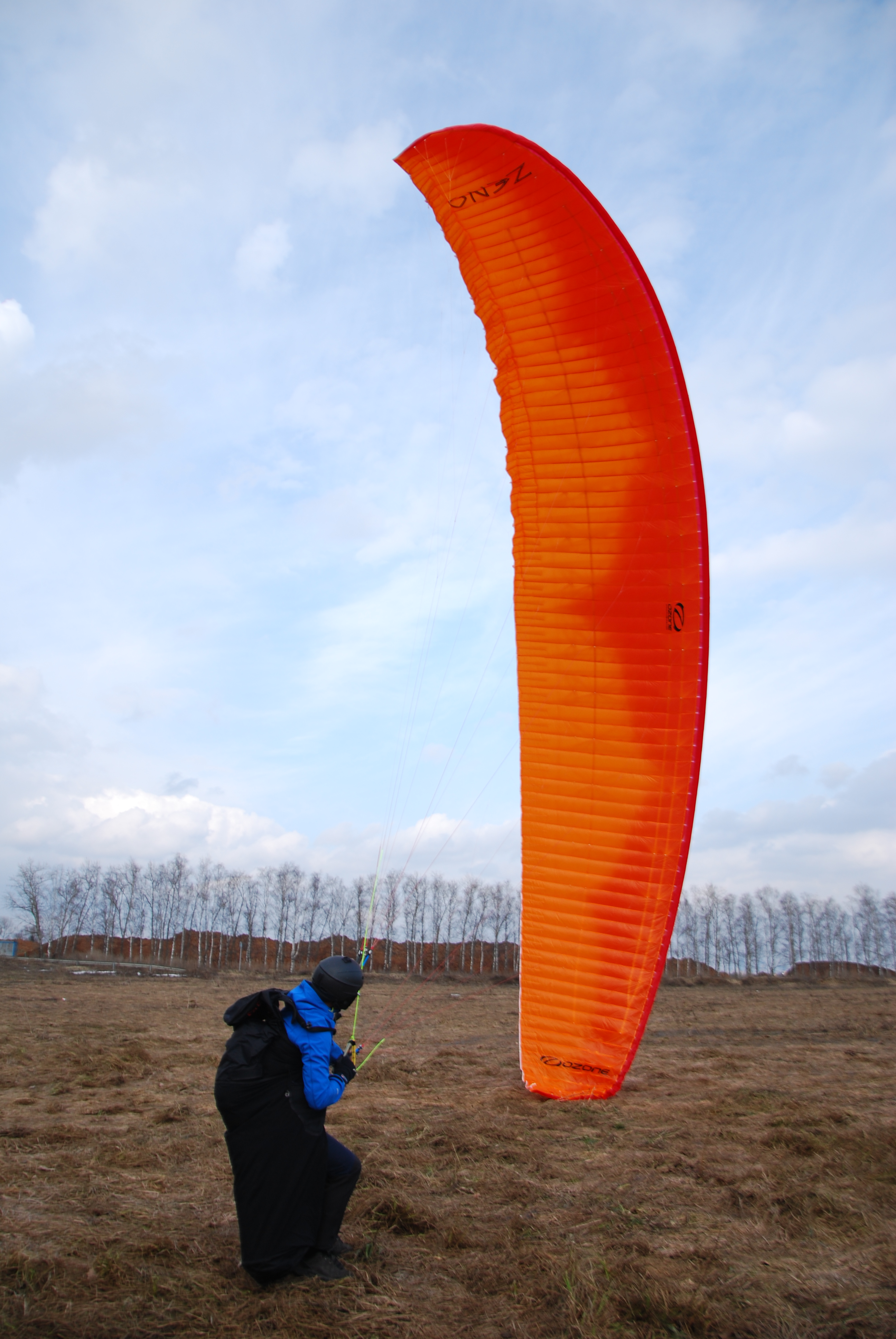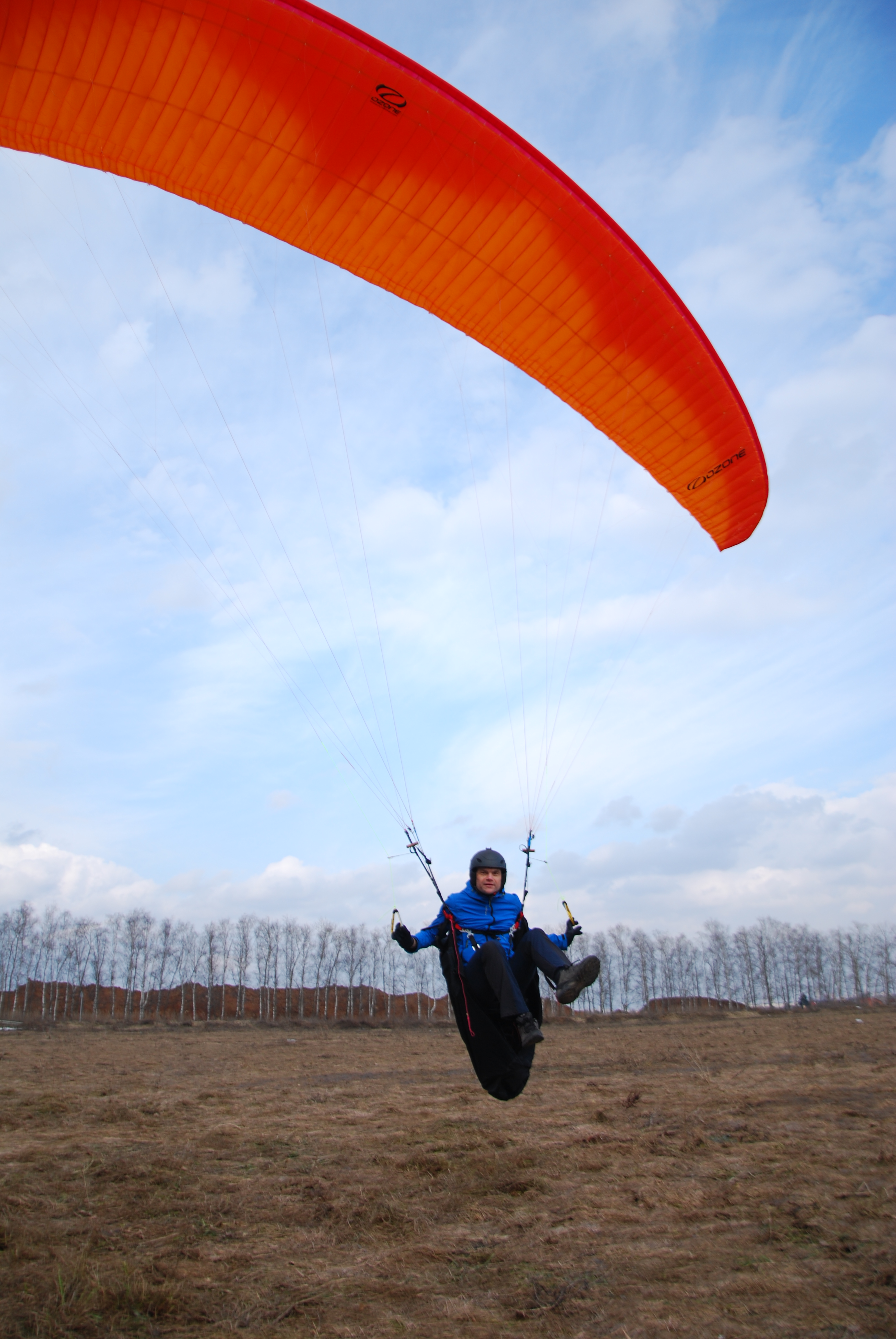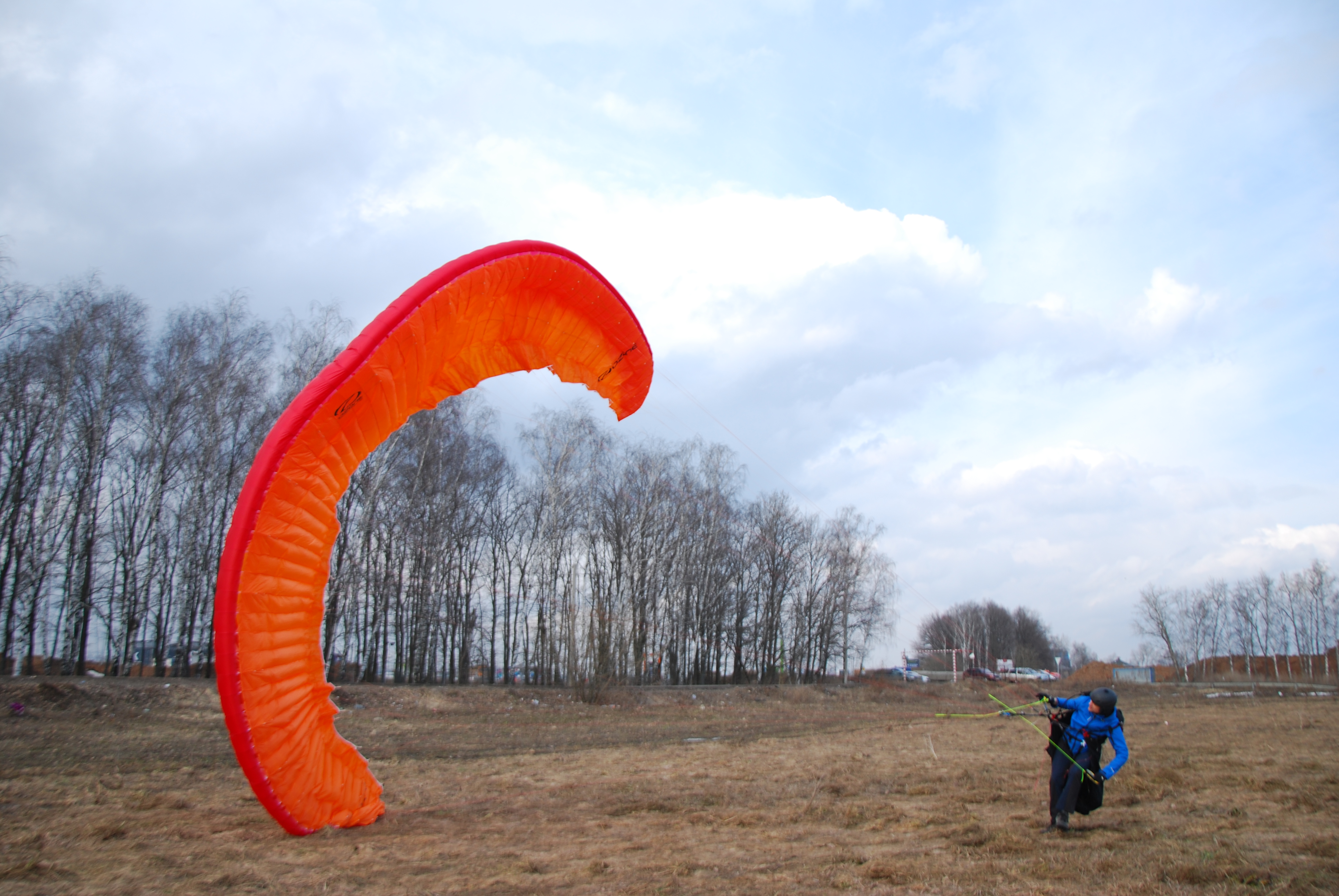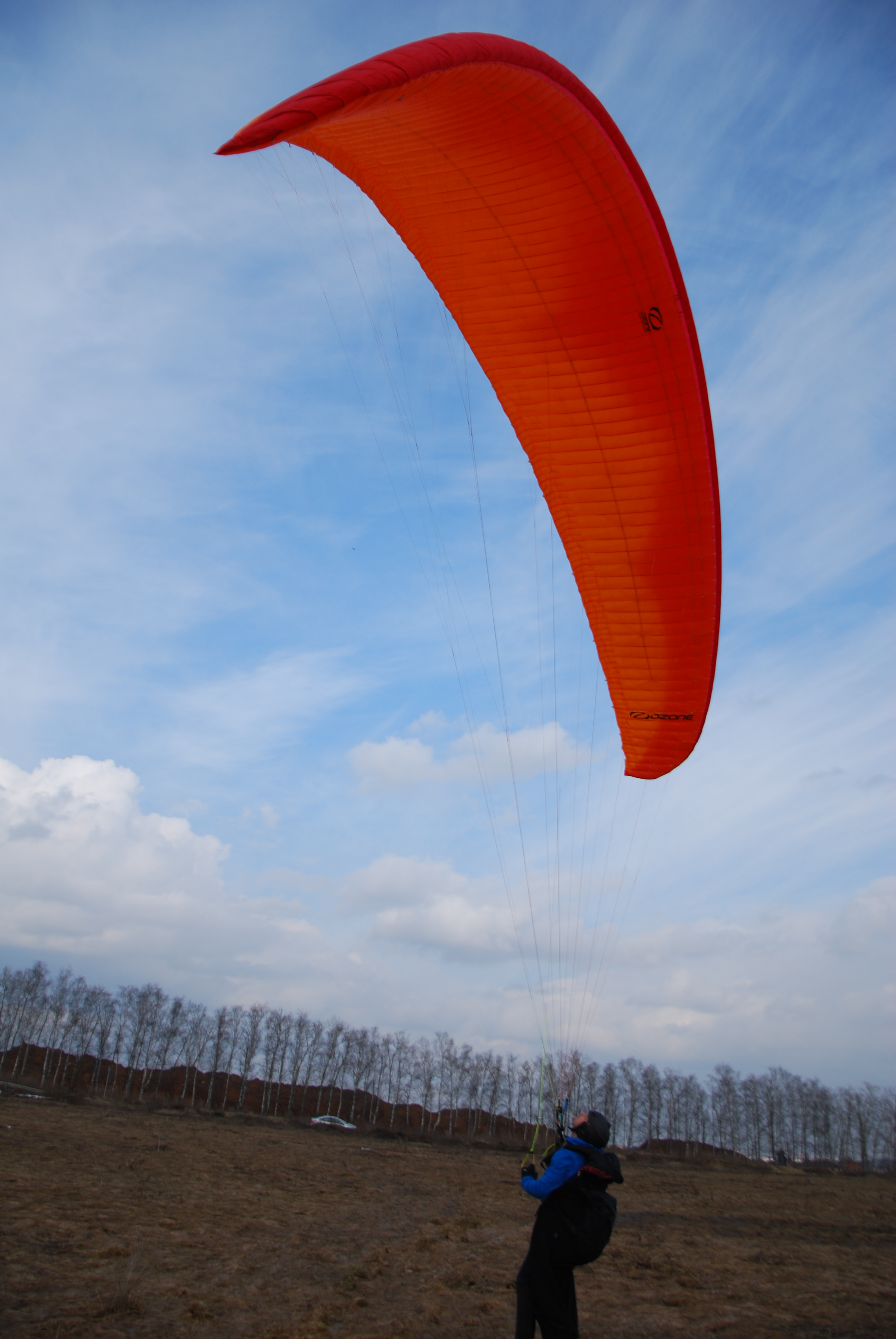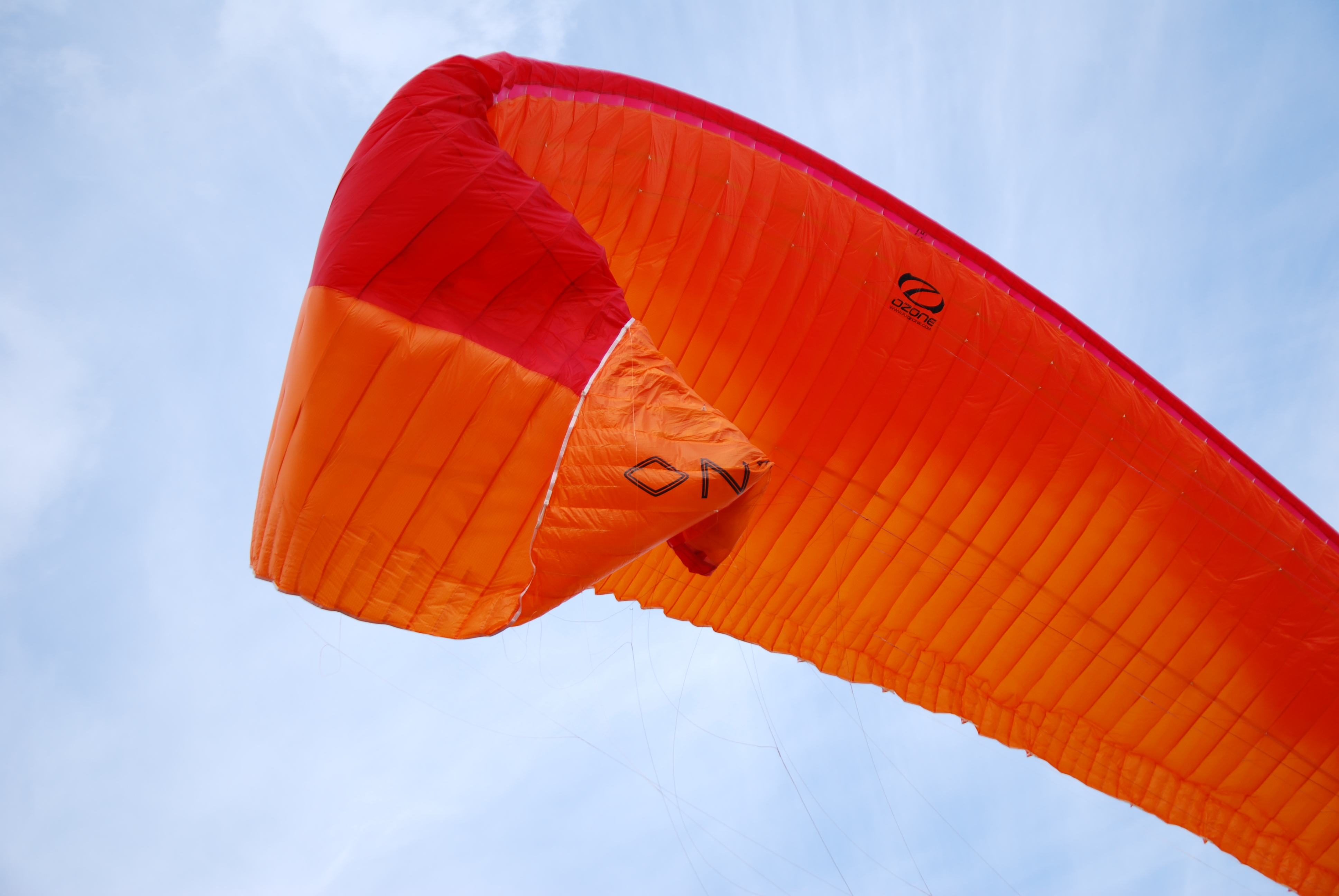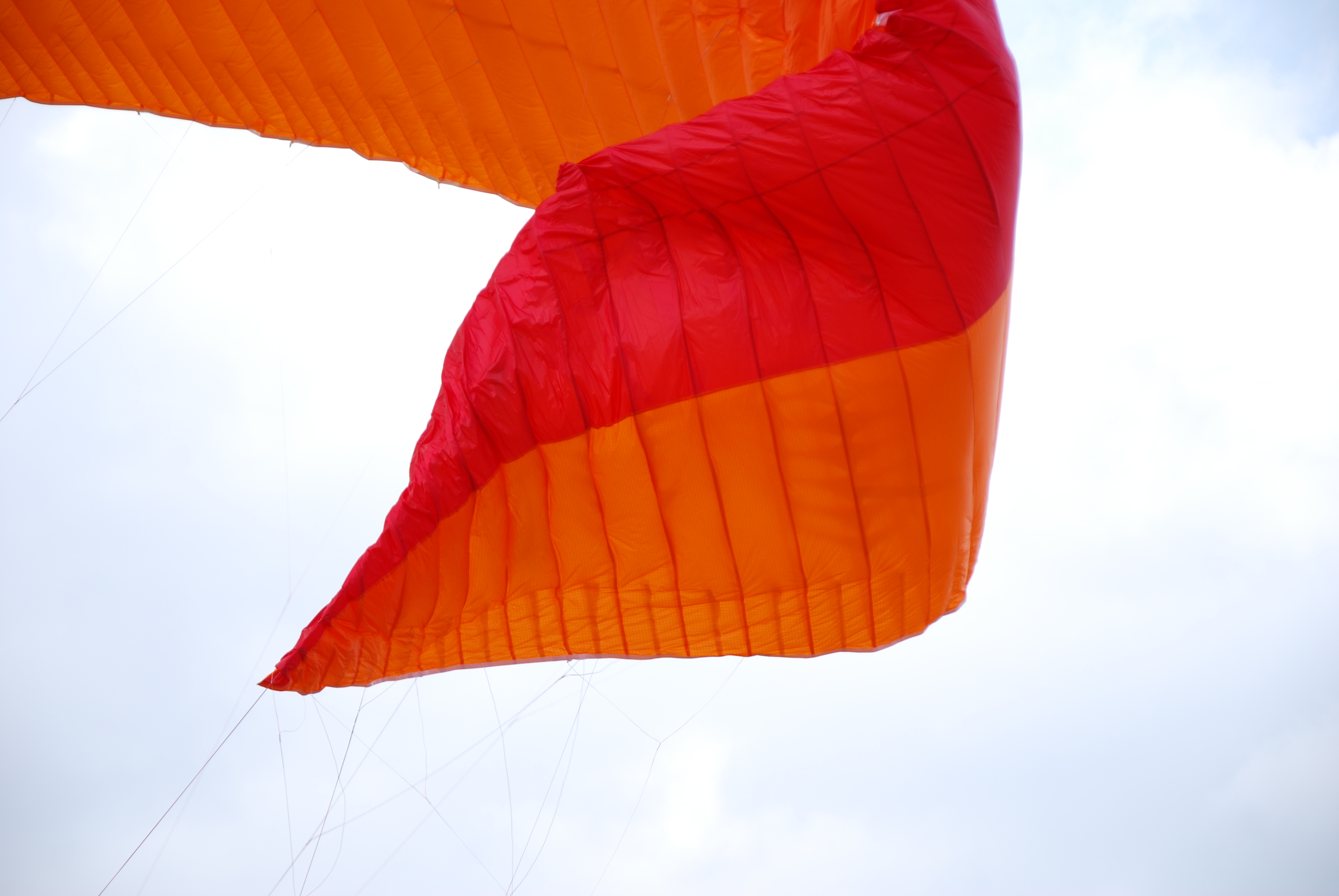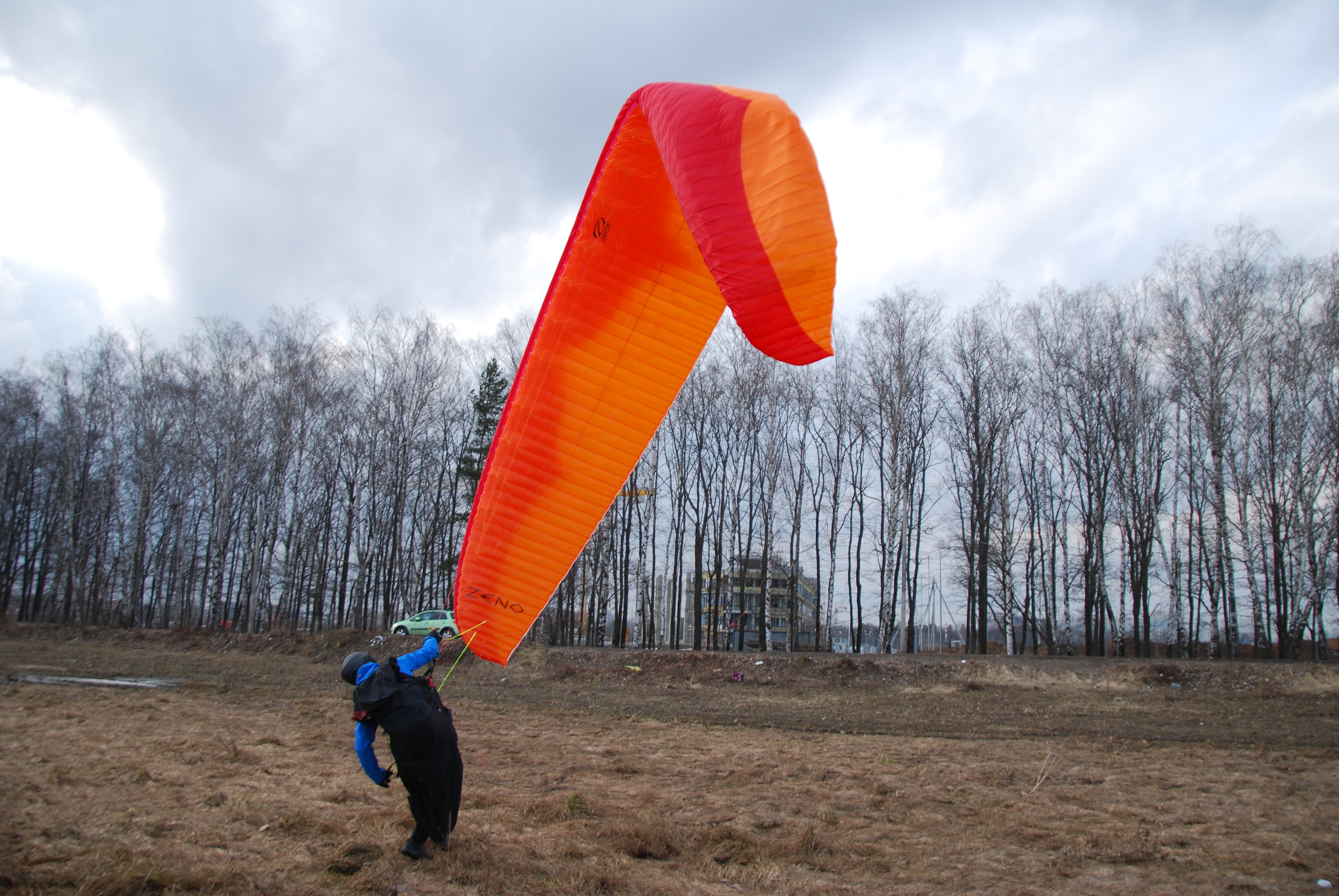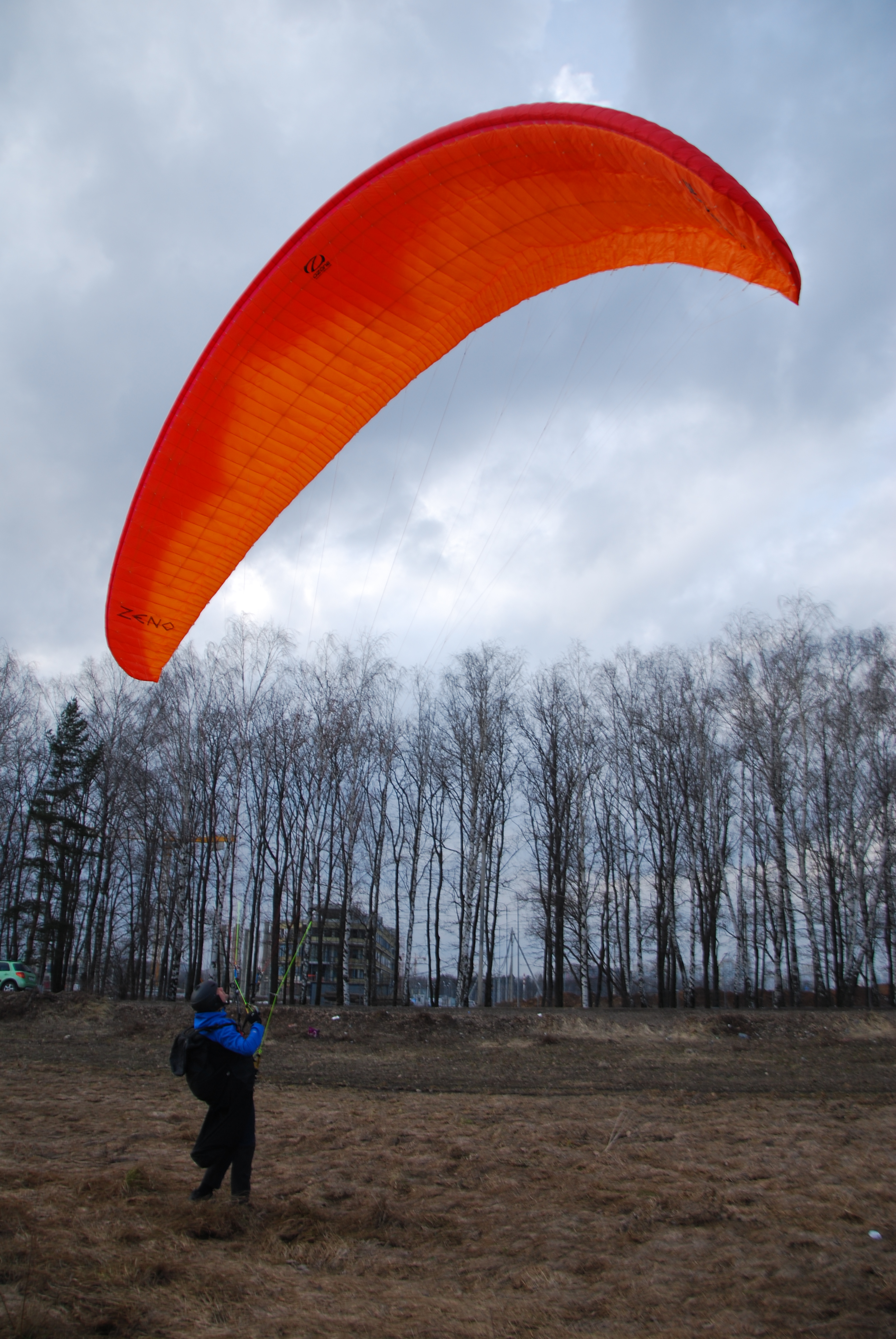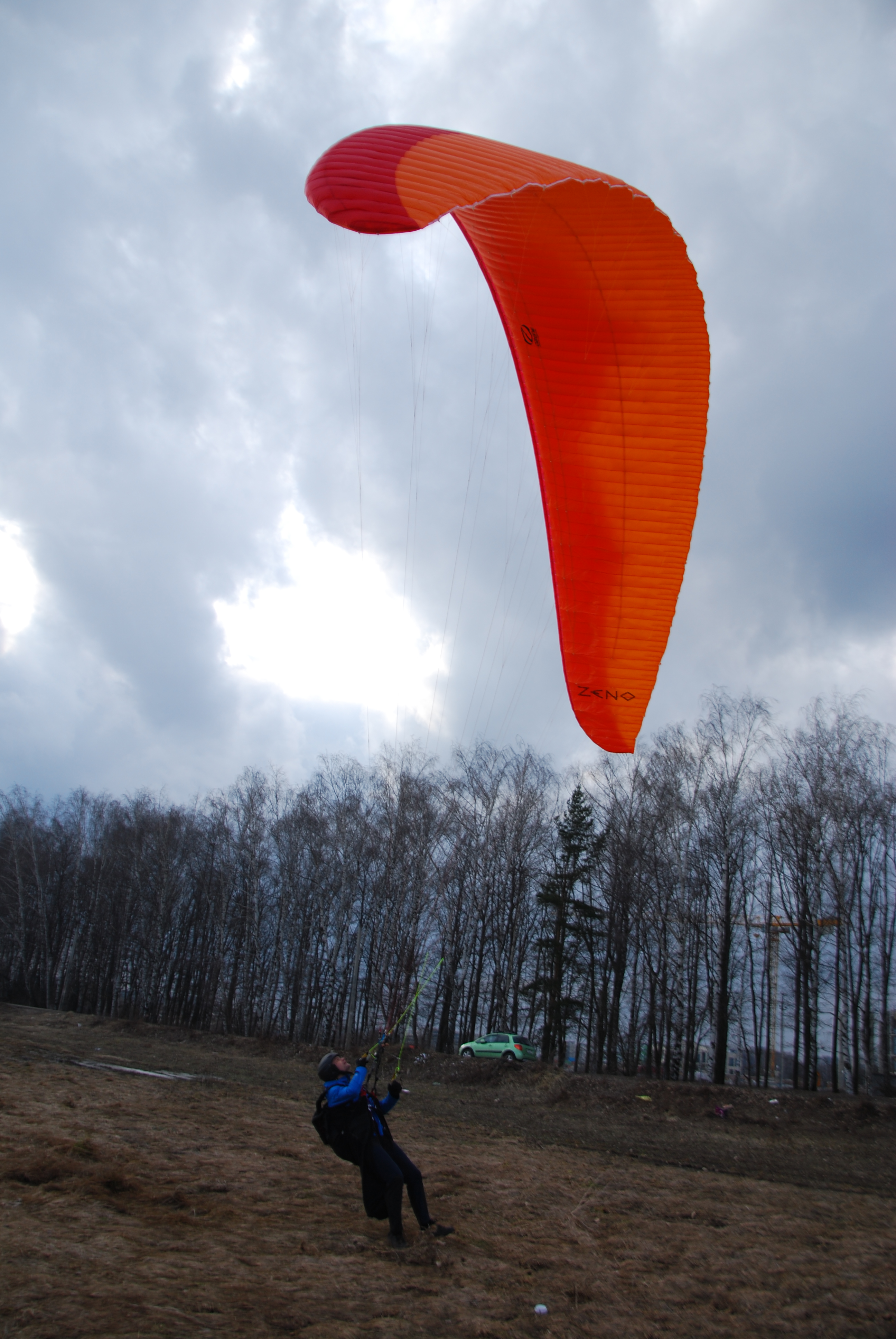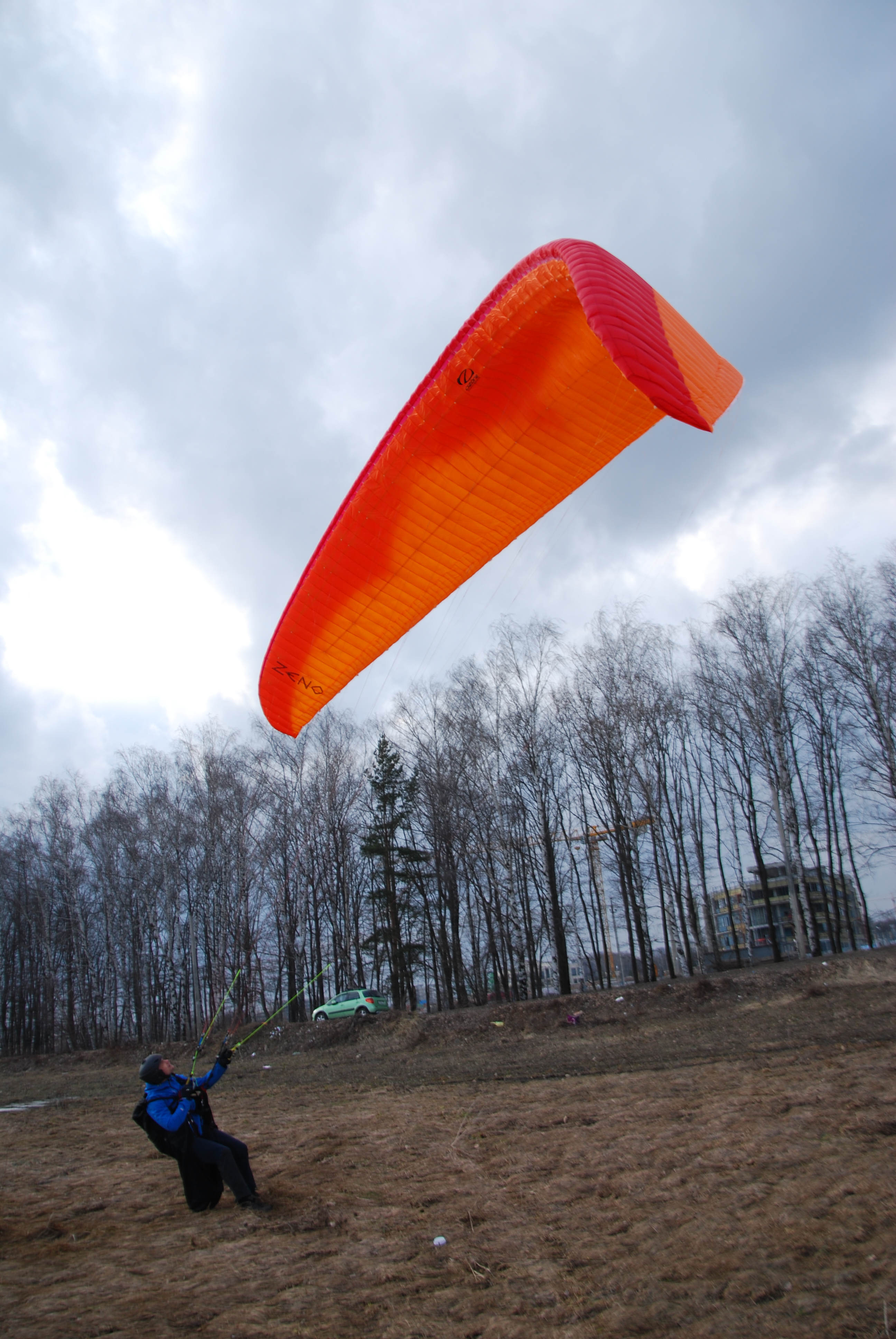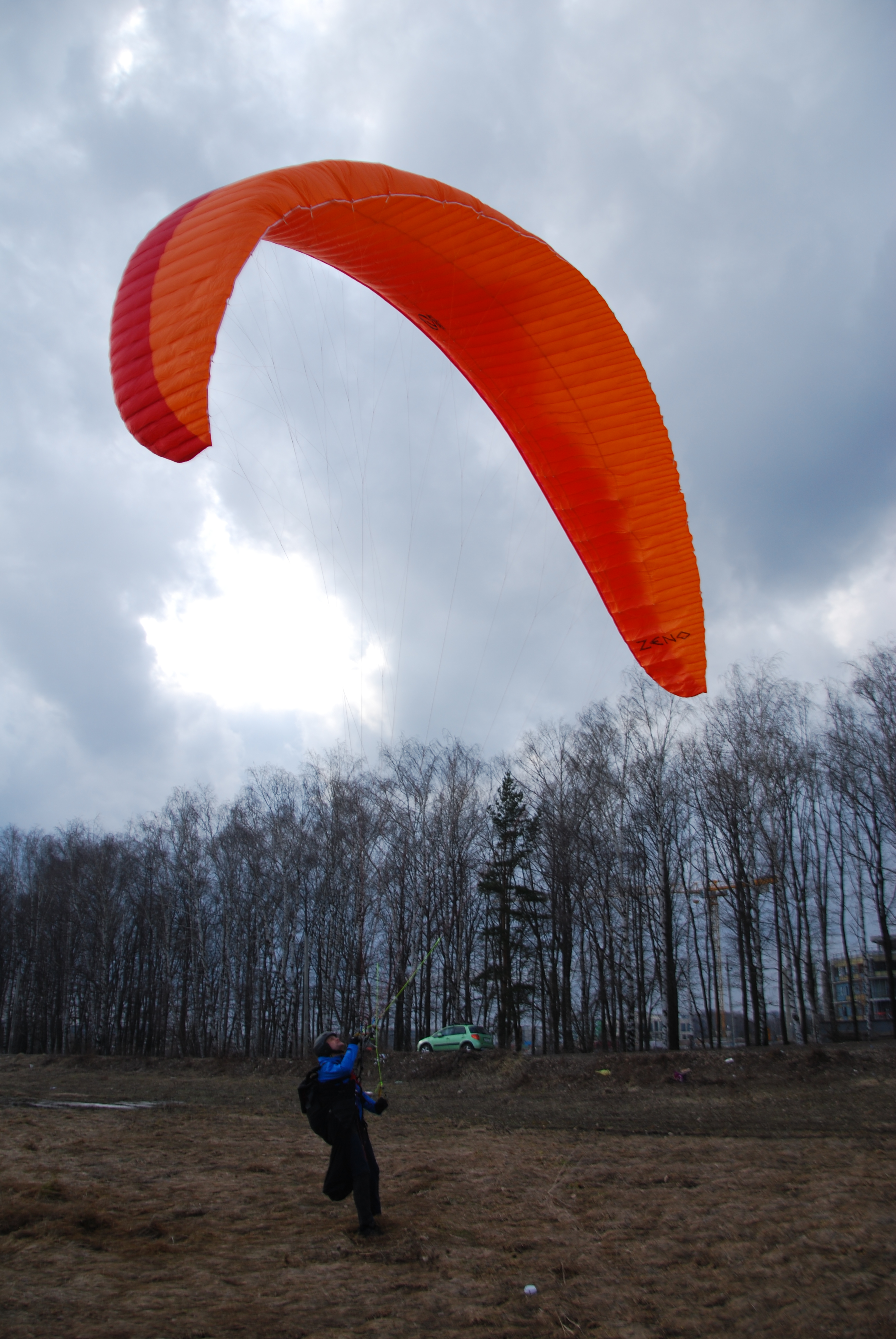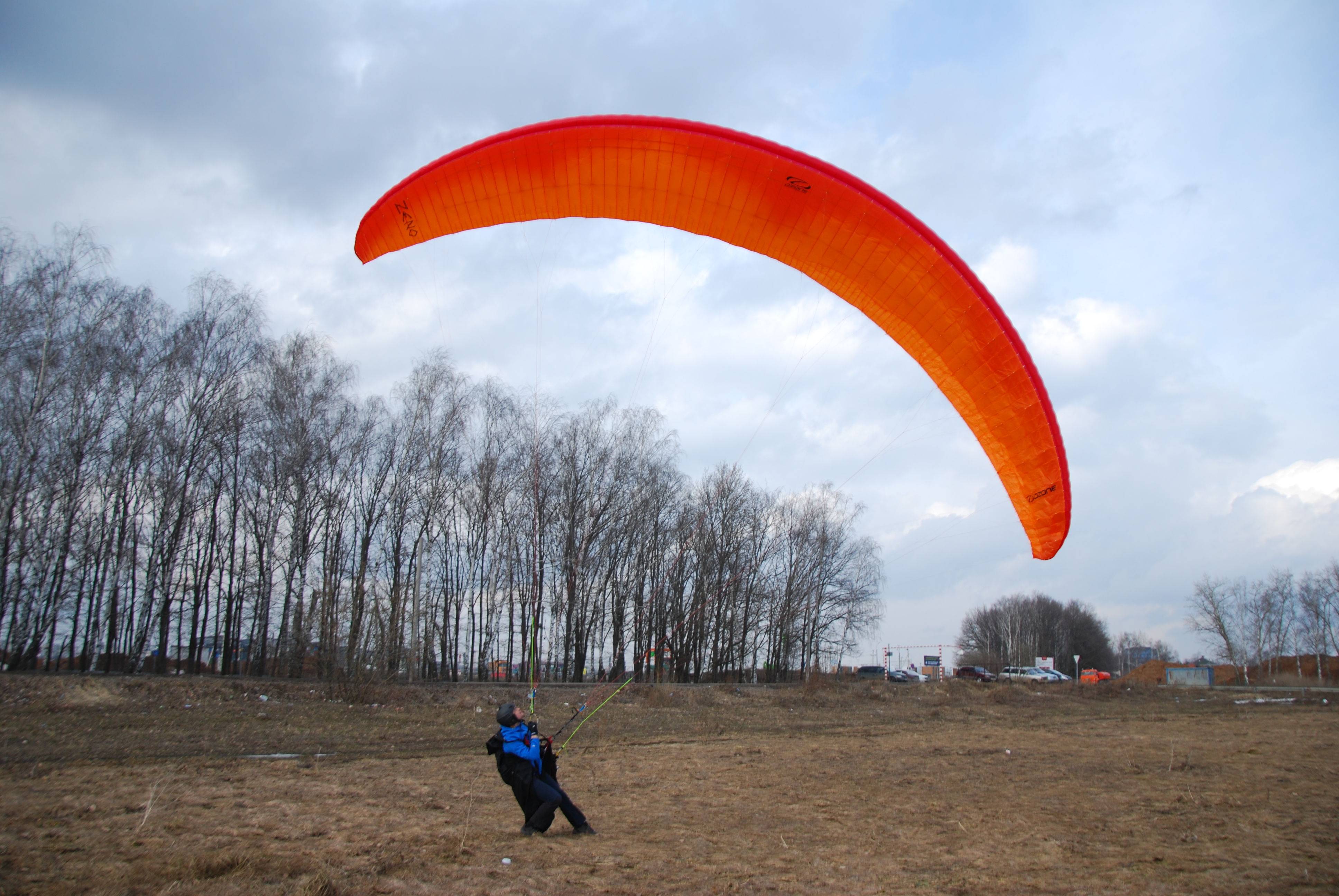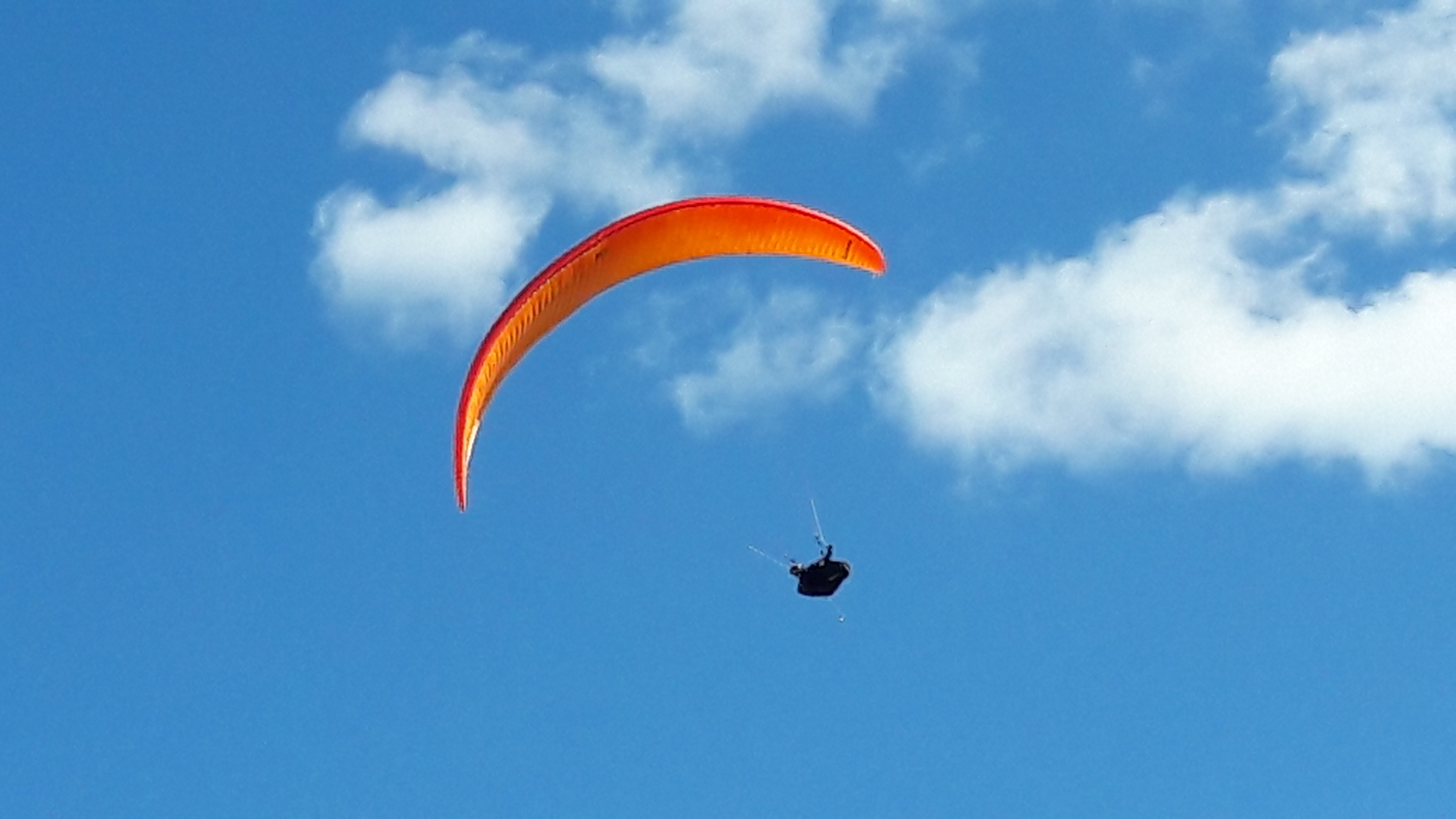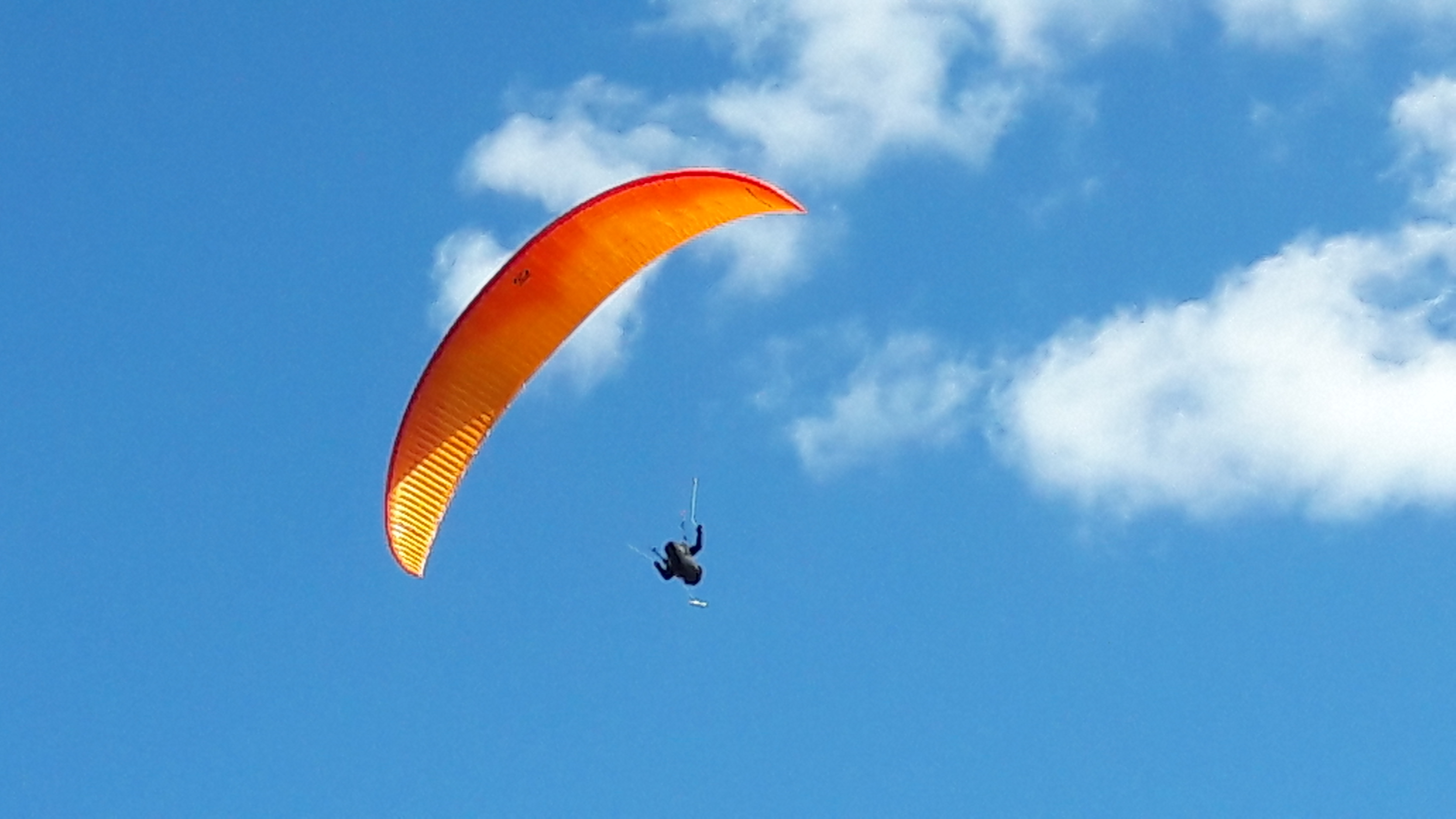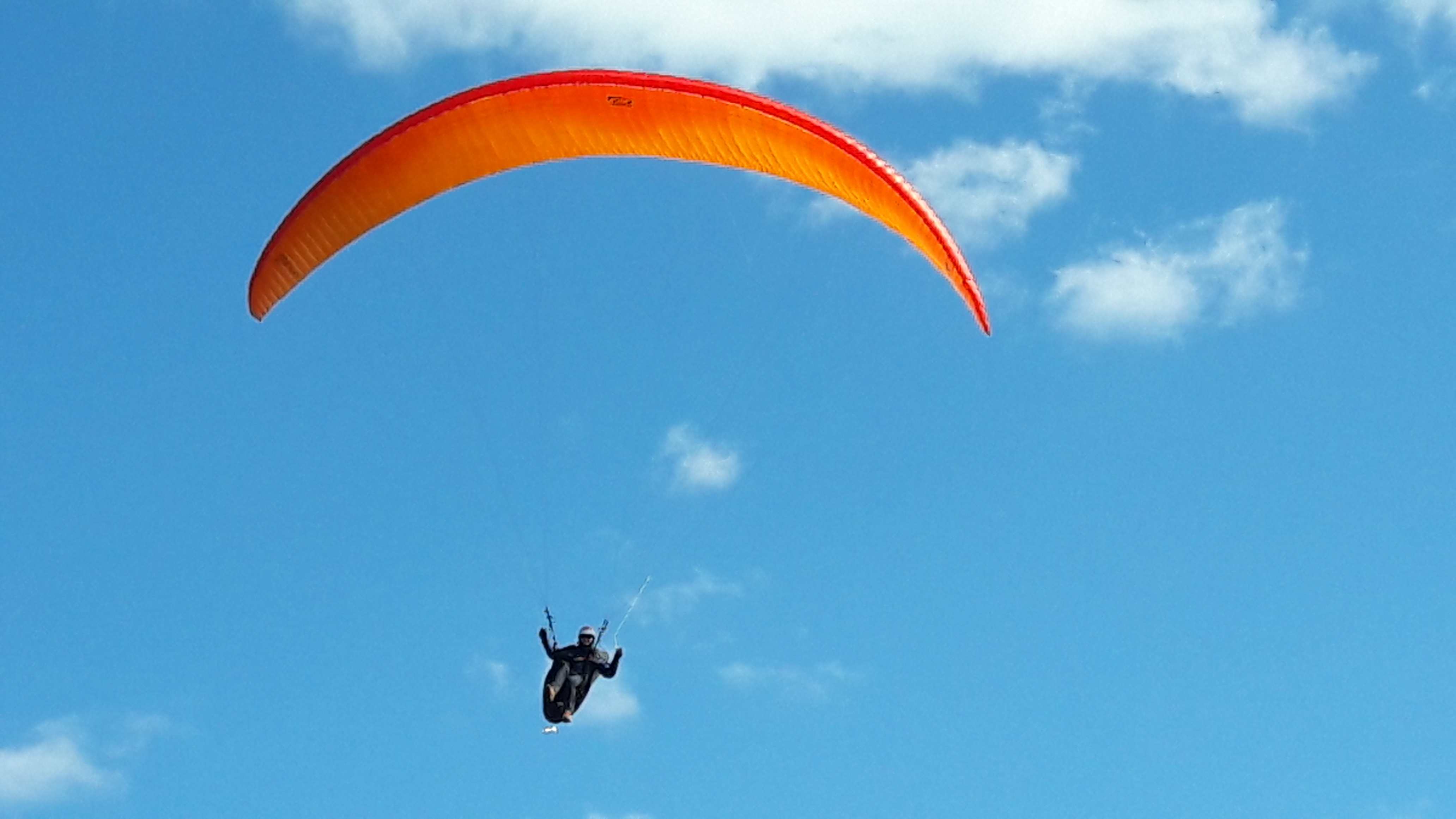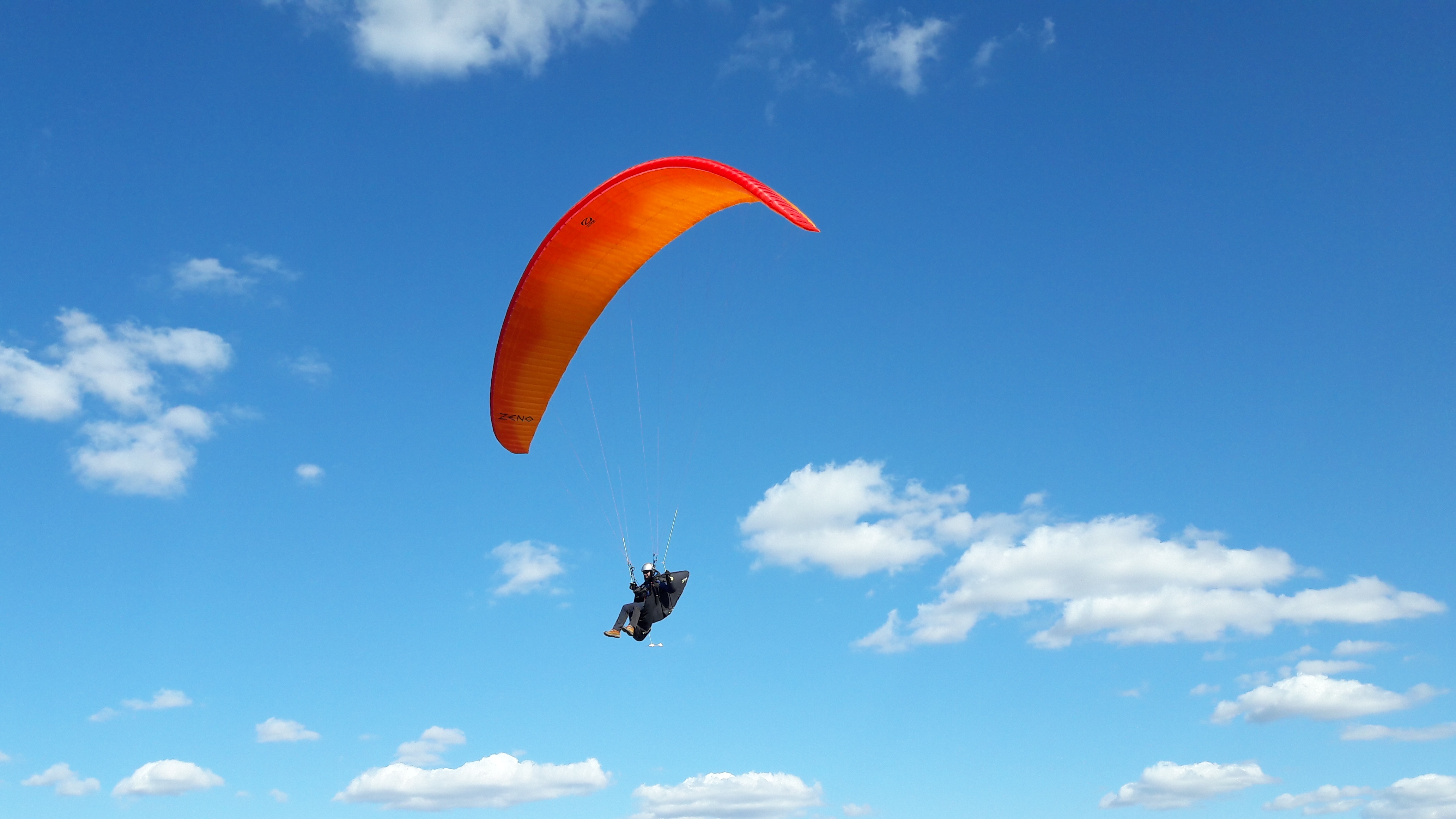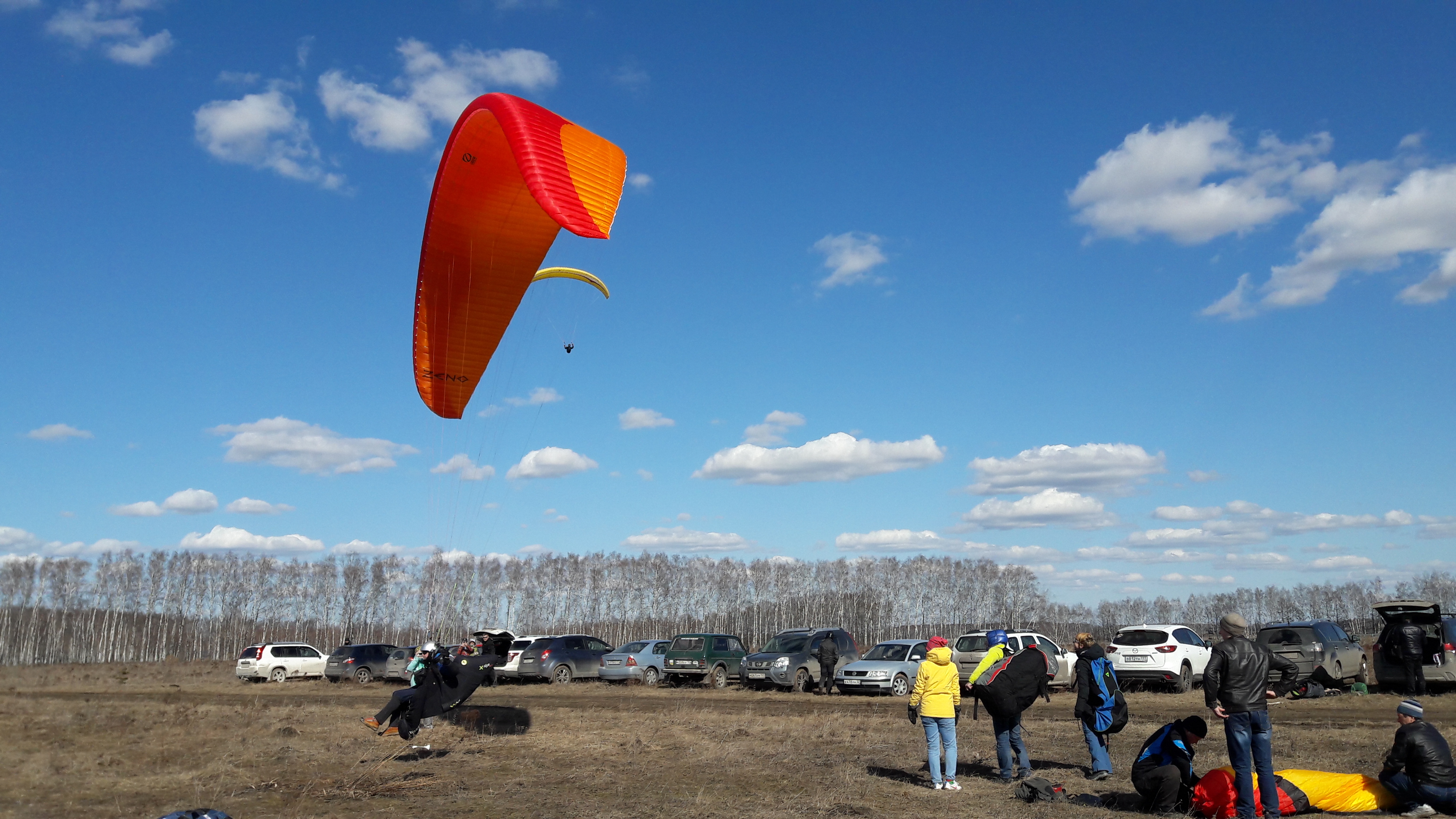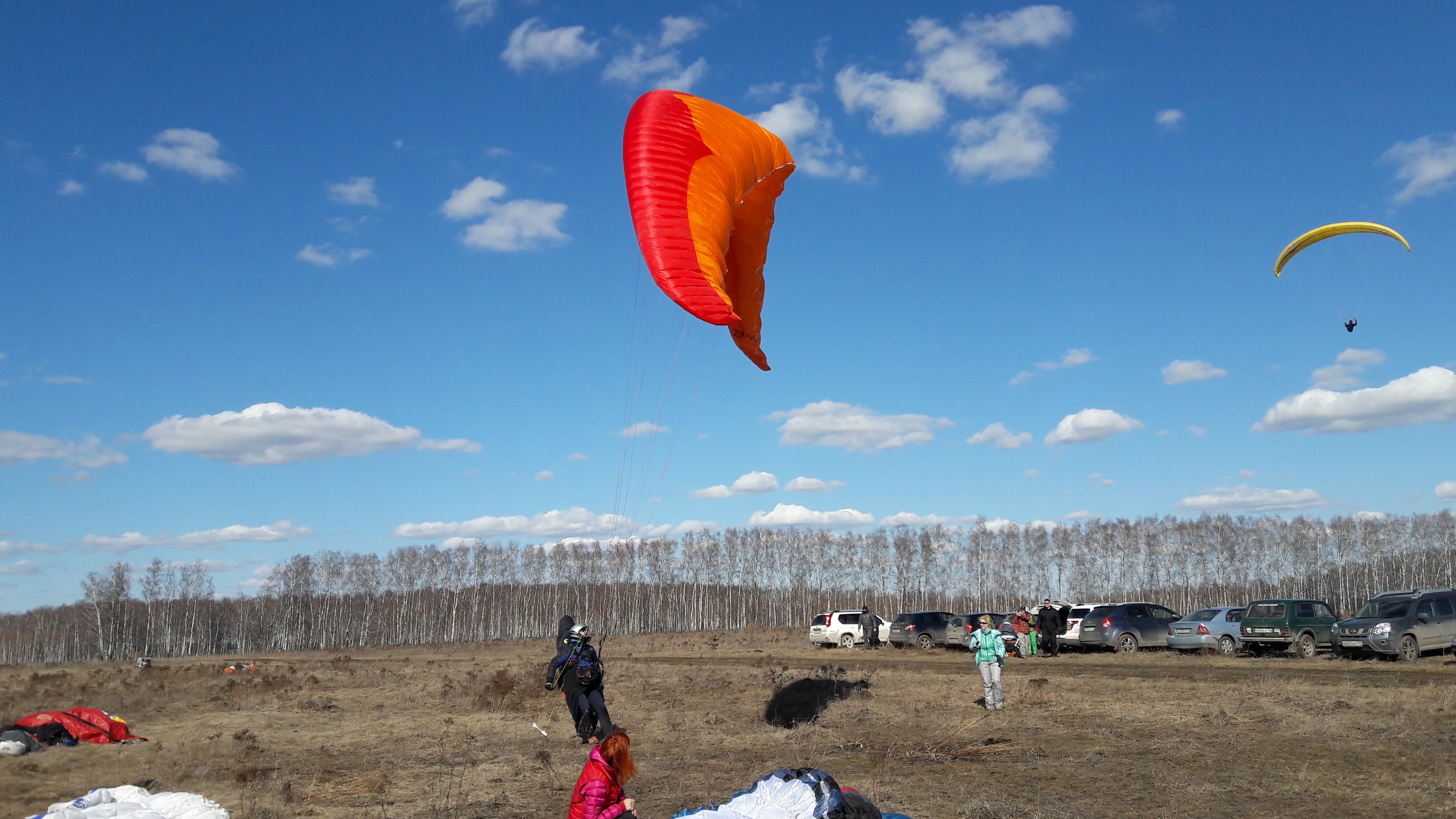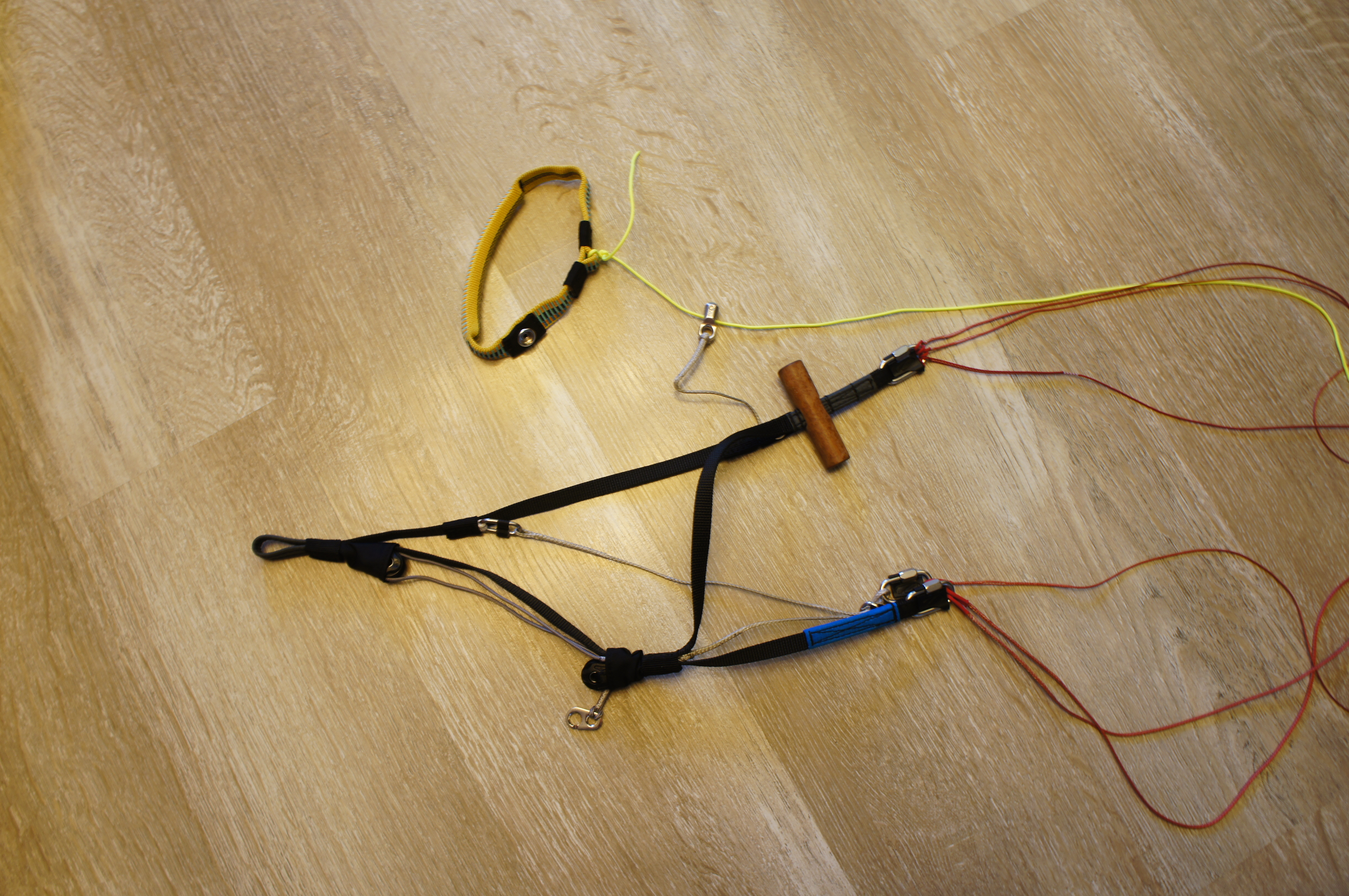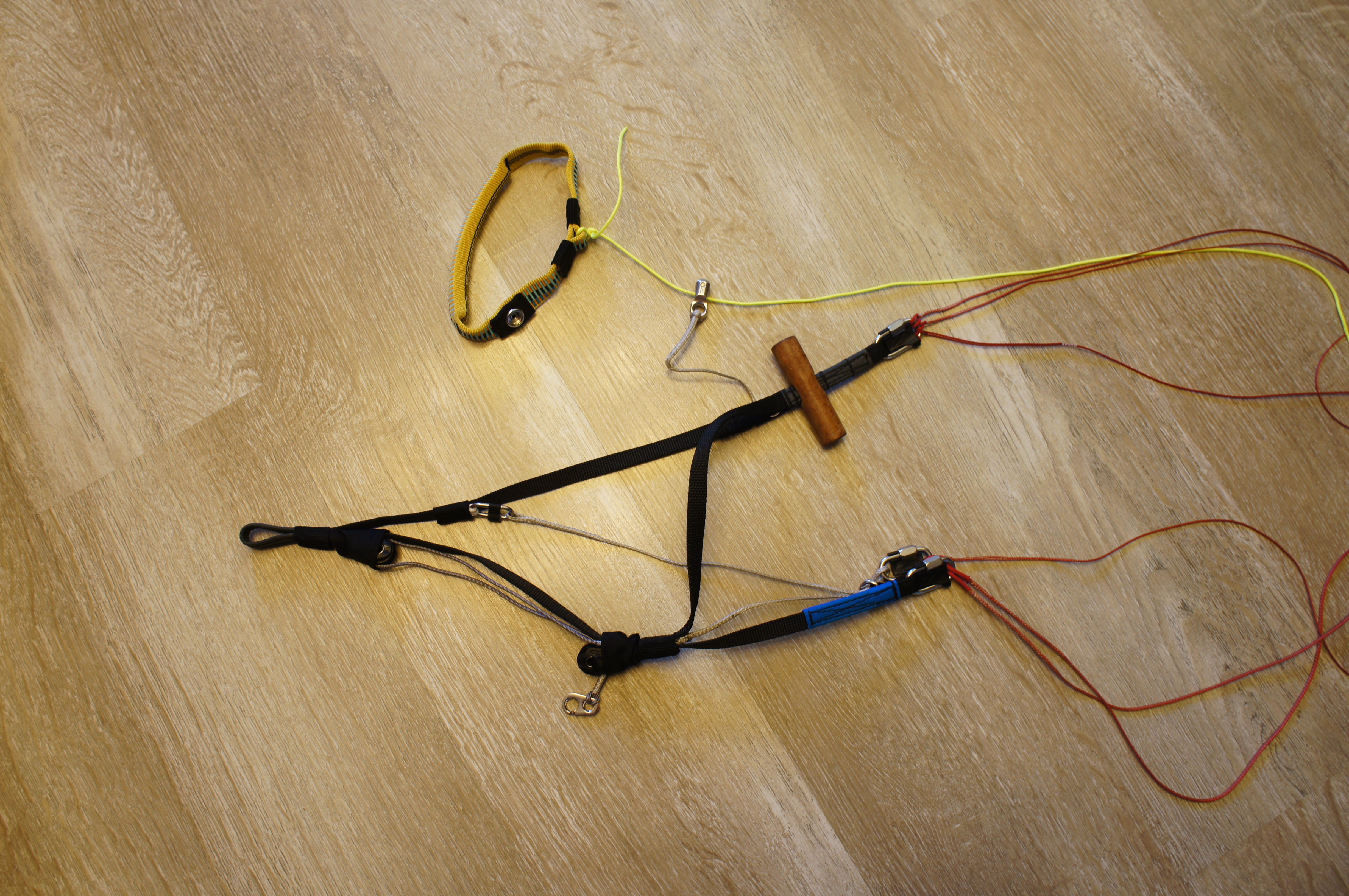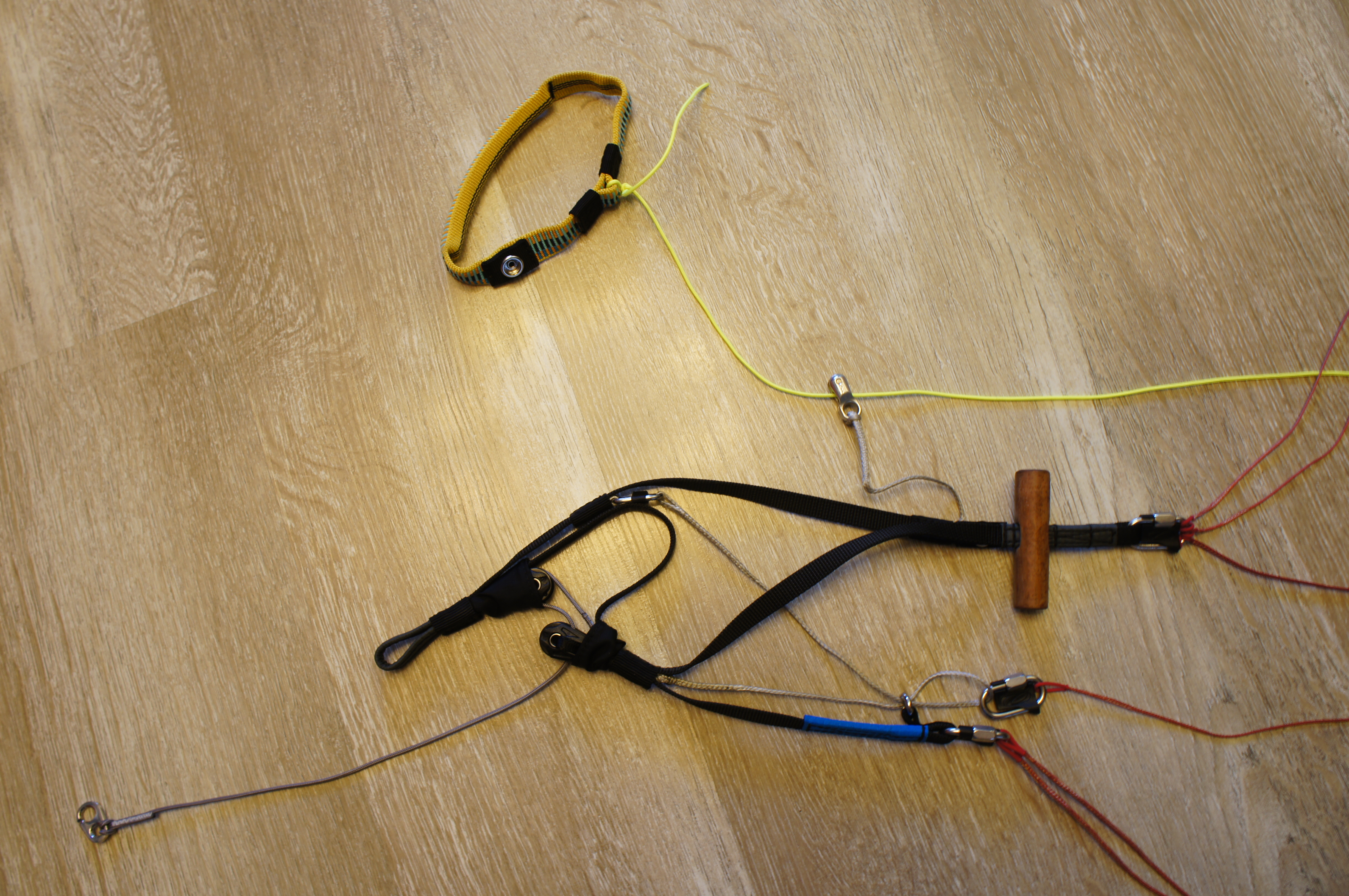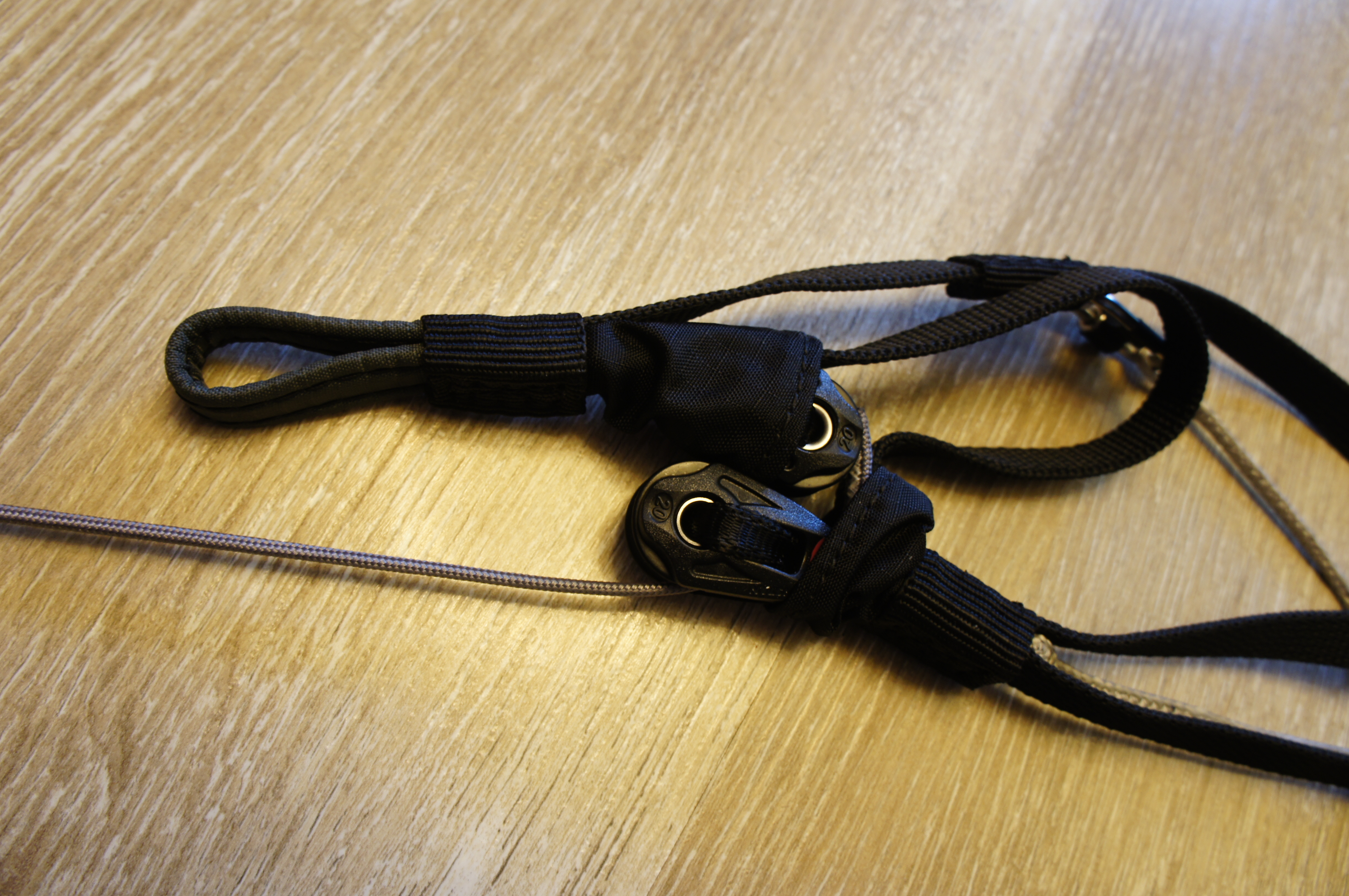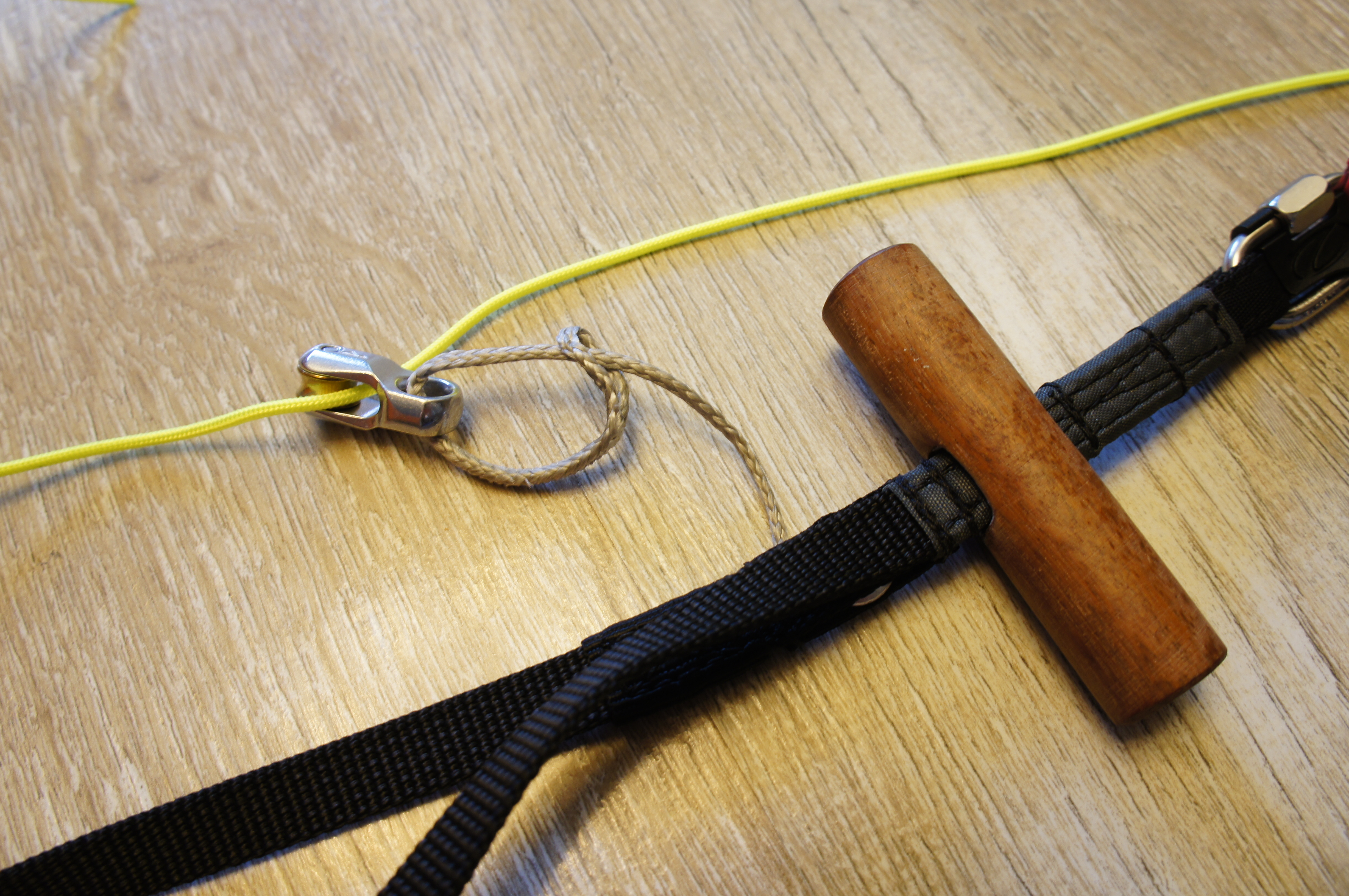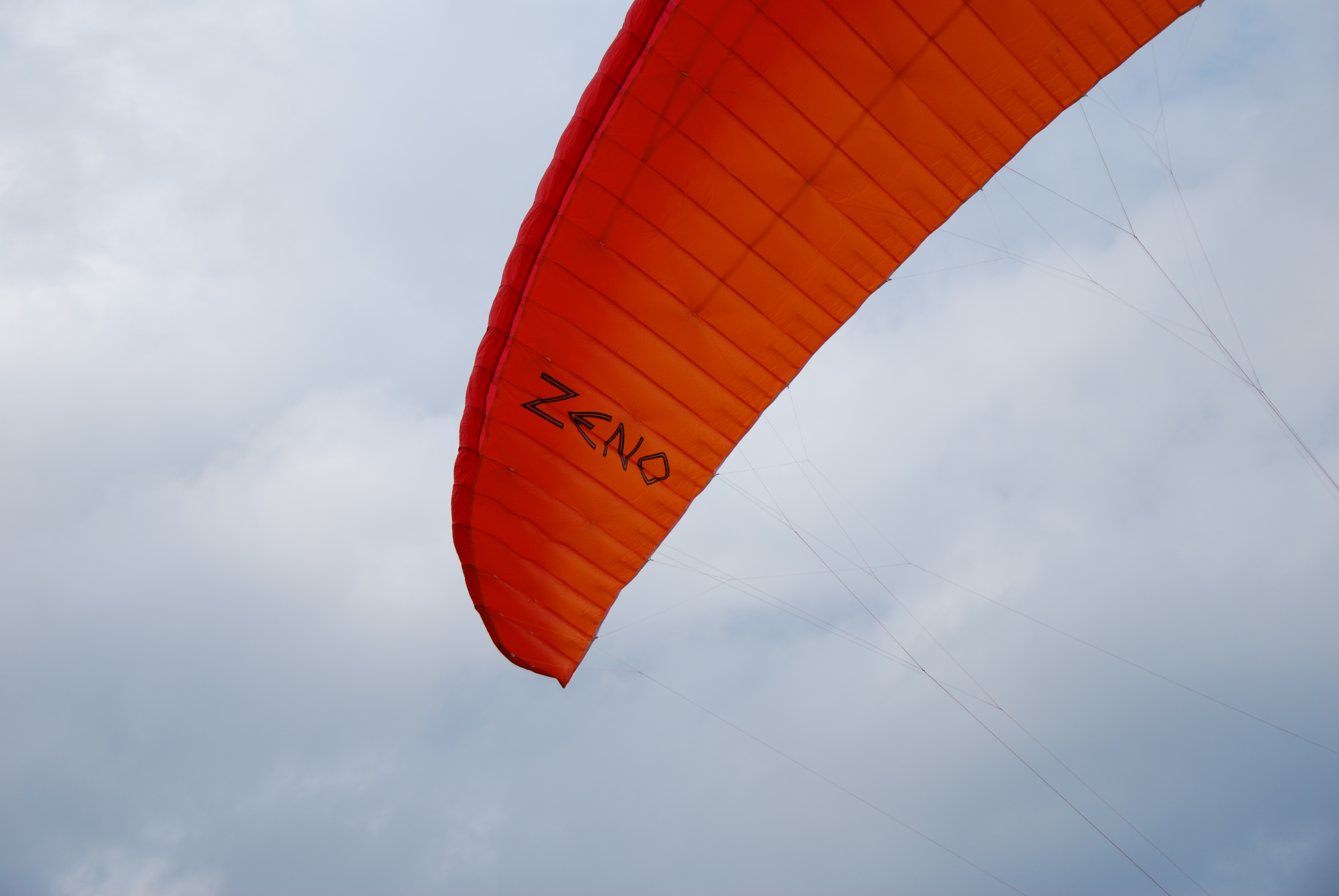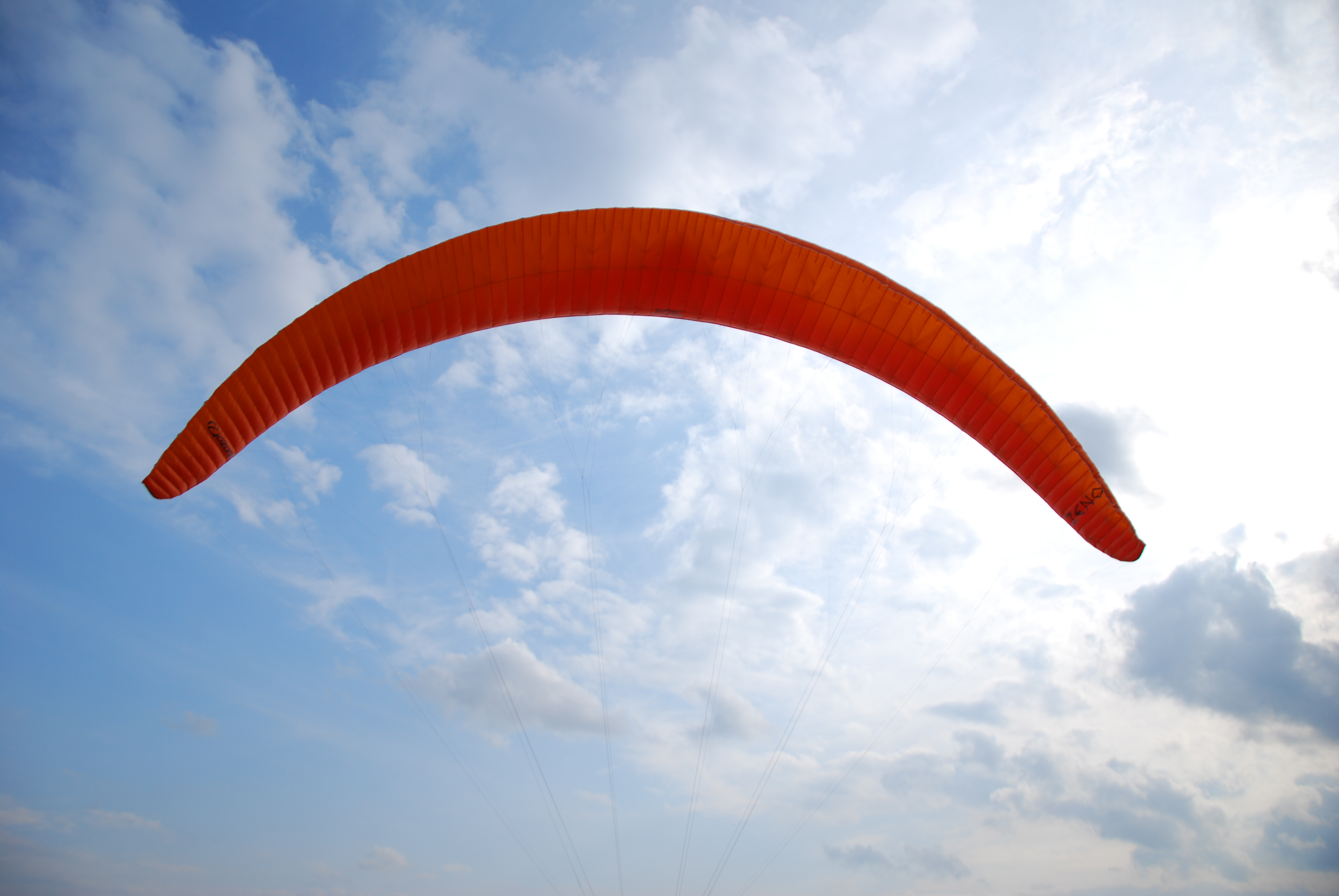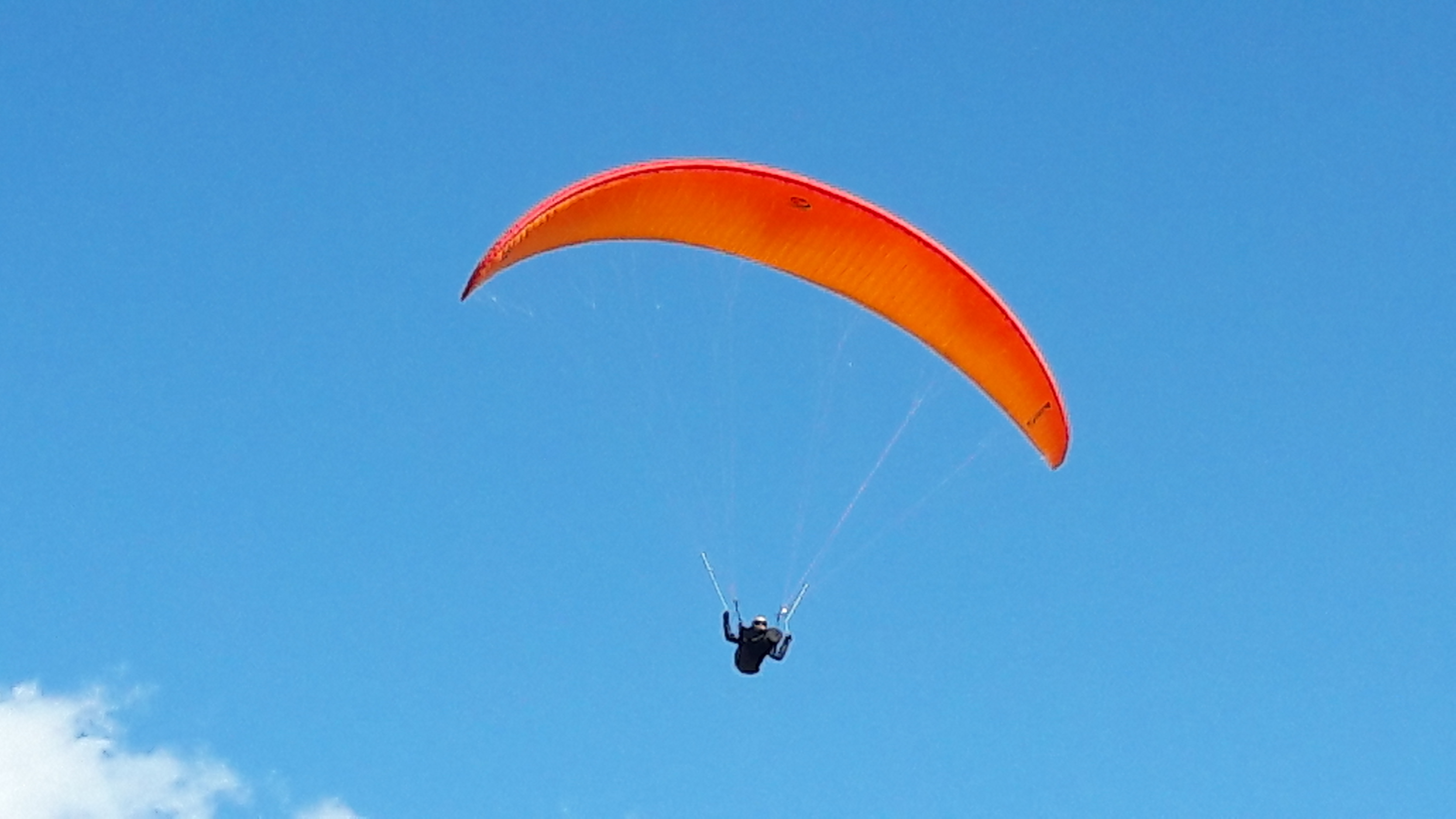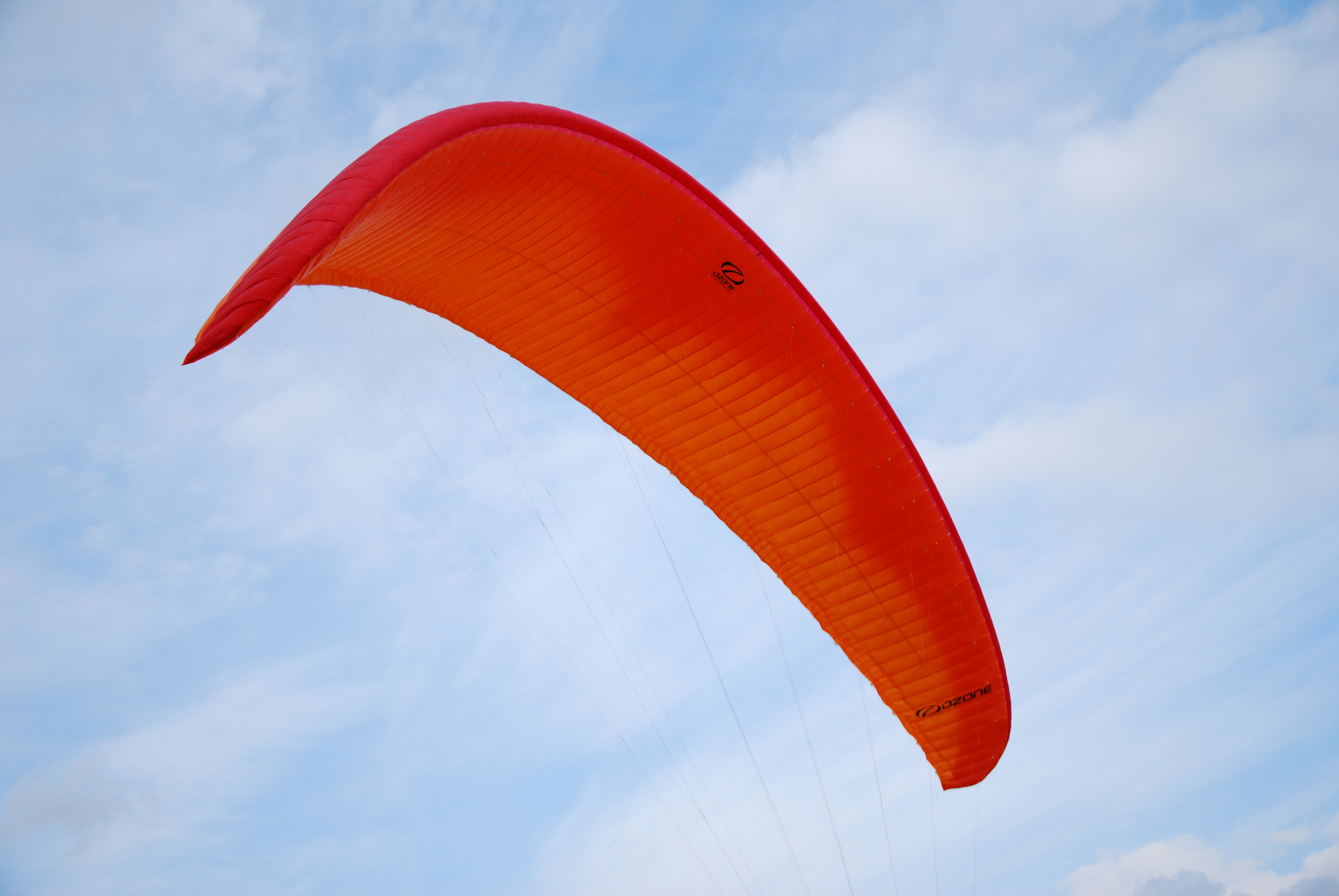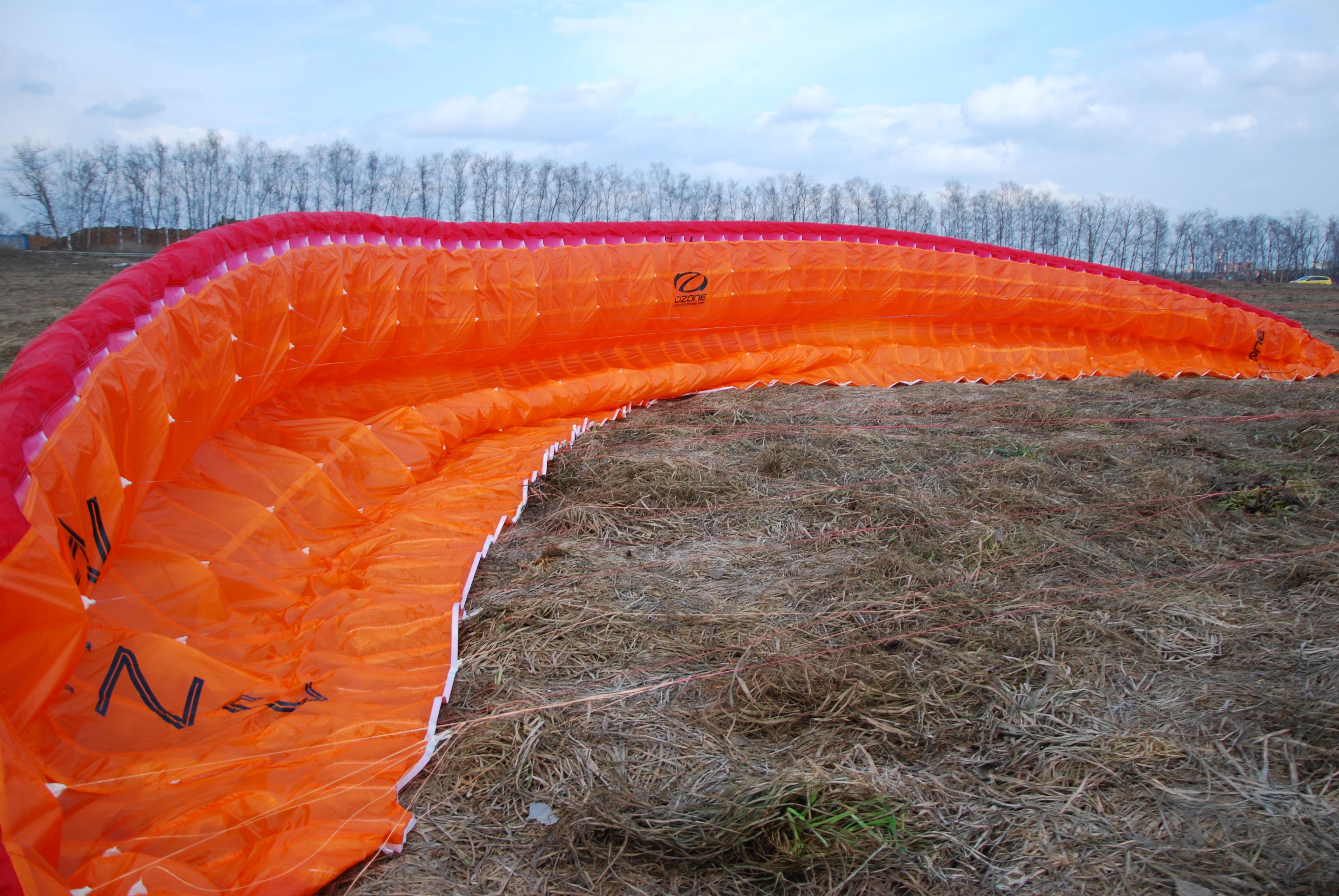Design
Completion
- The wing itself (without the concertina - aye-aye! - in a cloth bag with a zip tie)
- Backpack (standard, no miracles)
- Marketing stuff: stickers, keychain and a branded beer opener (subtly suggestive of the subject's character)
- Protocol of measuring lengths of slings
The loose ends subvert the mind into a state of transcendental meditation. There is a lot to get caught up on, simply put.
There are few slings (A1A'1B3). On the lower tiers, it's mostly thick unstitched Lyros. Judging by the thickness, very strong. The outer back row sling is partially braided. There is no dedicated "anti-tack" sling.
Gas pedal wiring blocks are large, quality, bearing. But - in the best traditions of Ozone - allow overlapping, which increases the gas pedal stroke by 2-3 cm more relative to the norm.
End kinematics - no miracles, everything is clear. The twist of the end sections on the gas pedal is reduced. I was surprised by the very powerful power band connecting the front and rear rows. Flashed a suspicion that it would interfere with the rear rows working on themselves - has not been confirmed by practice.
Very cleverly made leash wiring paddles - just a sling with a snare loop. Now in these hinges there are rather massive all-metal blocks, but nothing prevents them to dismantle and put, for example, ceramic.
I didn't like the knobs of the brackets. Uncomfortable. The only good thing is that they are big. But for some reason they are fixed on the buttons. I think the magnets will be more convenient.
I have my connectors in real metal. No softlinks. And they would have been very appropriate on such simple and lightweight ends.
Uber-brutally made handles for back row work. Natural wood, polished by none other than the hands of virgins on a moonless night. It looks kind of, ahem, clumsy. Or was it turned? But the grip was comfortable.
The wing itself. Very aggressive shape with unusual looking "ears". Lengthening is typical for an ambitious EN D or simple compétition: almost 7. Surprisingly many sections - as many as 78 pieces! Tiny fences with a pronounced shark-nose. In many ways the aggressive form of Zeno corresponds with the forms of legendary racing Mantras, but Zeno has its own uniqueness, its brutal charm. Scares and attracts at the same time. The workmanship is standard for high-volume Central Asian production, all quite good.
Work with the wing on the ground
If you reduce your impressions to one word - it's wicked. Not mean, as it is in the upper semi-class, but mean. At the level of a pit bull puppy or something like that. It can bite, its teeth are small and sharp, but it will not cause any serious damage.
Another analogy. You can remember the legendary picture of the DHV class-marked chicks. In that picture, Zeno would have to be portrayed as a depressed goth girl with no complexes, but also no intention of morally destroying her boyfriend. She could send him away in plain language. Make a scene all you want! Demonstrate the ostentatious paternalism, it's okay. But this unbridled girl is incapable of real meanness. Fortunately. And if you can feel that your skill is enough to control her, then there is even a certain perverse pleasure that comes from such a relationship.
From analogies to specifics. By analogy with the degree of dual circuitry in engines, I will introduce the notion of the "degree of duality. It is quite high in the Xena. The high degree of dual circuit manifests itself in the ability to turn almost inside out on the ground, like the Mantra R 10.2. May hinder a lot at the start, especially in a strong wind and without helpers. But it comes out surprisingly easy - both in terms of effort on the front rows and in terms of speed. Probably will be easy to start in a doldrums (just a guess, because I tried it in a rip top wind).
Immediately after the Zeno goes overhead the wing profile shows up in all its glory. It is clearly unstable (not reflex), with high aerodynamic quality and, therefore, no damping. The Zeno is easy and simple to "shoot" forward, insisting that you catch it with the brakes. The typical EN D in this respect is much, much simpler and wobbly.
And now it's time to remember the lines... No, fishing lines. Huge, thick and stiff. They hold the shape of the wing to the last, but if they stop holding it, it's no good. The apparatus folds sharply and knits ties very readily. When I was not used to it I made three ties in the first two minutes of ground work. Then I adapted a little and learned to knit or not to knit them at will. Let me remind you that we are talking about ground handling, in the air the situation will be somewhat different.
The nature of the triggered folds on the ground is strange and unpleasant. The strange thing is that right in the process of folding, the machine tips over noticeably on the UNLOCKED side. Checked it many times, I'm sure. It is very difficult to press the leading edge before folding. It takes a lot of force and very long sling travel. When folding, the rig goes straight ahead and tries to accelerate powerfully. Then comes the unpleasant unloading phase when the bracket does not develop lifting power any more, but saves the form due to the lines and internal pressure. Then comes the ONE. WAITS!!!!11 Most of the wing just disappears. Shovel. The break line goes over about 70 percent of the chord - a very dreary scenario. Immediately after folding, the apparatus abruptly tries to unfold, but it does not do so very well. The folded console wriggles and "shoots" its separate parts. The "ear" in particular "shoots", which tends to get somewhere in the sagging lines and joyfully jam there. The only rejoicing thing is the high efficiency of the brackets, which makes it possible to nip all this mess in the bud, or at least loosen the ties with a couple of movements.
I also dislike the sharp increase in resistance of the folded part of the wing, especially if you get a tie. The whole wing is noticeably moving backwards, and the brake travel before stall is greatly reduced. It is easy to overcompensate and come off.
An odd thing is that like some kites, sometimes Zeno suddenly gets stuck at high angles of attack. The wing goes back a little and stays in this position for quite some time, giving up on the bouncing and trying to shake it off with the forward rows. Goes away by itself in 10-15 seconds, and what exactly makes Xena return to more sane angles of attack - not yet understood. I notice that something like this sometimes happens to Xena in the air as well.
The general viciousness of the subject is downright hilarious. The kicks, the jerks, the wobbling back and forth, the frantic energy... A couple of times against his will jumped to 3 meters upwards, once such a jump turned smoothly into a flight with the prospect of coming to the speaker from the forest belt, I had to tear it off. At the same time the paddles are not ozone sharp and effective. The ground contact test is easy and uncomplicated - my ears hold the load until the last moment, and the control efficiency is good enough to spare.
In general in terms of ground handling Zeno is technically much easier than CCC, but is quite comparable with them in sharpness and malevolence. But if such not boring "ground electronics" is the price to pay for a record-breaking flyability, I can understand people who are ready to eat this cactus. Let's see how it is in the air...
Towing
the first seconds of puffing, the Zeno suddenly reminded me of its "little sister" in the line, the Mantra M6. I expected a sharper reaction to the brakes from such a mega-product, but no - during the tightening process I had to constantly steer with my weight, to which Zeno also reacted surprisingly calmly, without sharpness. In the choppy spring air Zeno was quite jumpy while being towed - the plane was constantly pitching and yawing, trying to go off course. The wing periodically shuddered violently as a result of sudden changes in load. I did not observe a pronounced roll back under thrust, but I did observe sudden sinking when entering "downshifts". It felt like I was getting close to parachuting, but disappeared on its own after a couple of seconds. I unhitched almost without thrust; therefore, practically without a flip. And right away - into the flow!
Flight
To be honest, a sports car with high sport ambitions should be tested in weather that requires aggressive acceleration, is generous with strong currents and powerful downshifts. And so it turned out! The frost under the cloudy base reached -13, killing all desire to fly far, and it was possible to avoid flying far only on one condition - to fly sideways to the wind and against the wind at every pass. Let's have some fun!
Starting thread. Pretty simple - not tangy and pretty strong. I try to get the Zeno to roll right away, but no way! Zeno is slightly behind Icepeak 6 in roll change speed, and if you compare it to Icepeak 7 Pro, the difference becomes very big, and not in favor of Zeno. The inner brake gets informatively heavy from the first 10-15 cm of travel, but the unit doesn't want to follow your hand - it requires dynamic weight work and guessing the right moments to give your hand and weight. Not a delight, but it is quite possible to spin. A few spirals later the situation more or less stabilizes, but I am still a long way from understanding the wing. Listening carefully to Zeno's reactions to the turbulent spring air, I try to keep the wing close to the core of the flow. At first it does not go well - controllability is lacking and Zeno constantly falls out of the stream, cheerfully going into quite amplitude wedges and just as cheerfully jumping back into the core. And here the power capacity of our test subject shows itself in all its glory. Power capacity of Zeno is not just great - it breaks the standards of EN D class and is typical for more "adult" equipment. While centering the flow around 2 on the averaging rod, the unit is capable of inadvertently losing 20 meters, but in the next few seconds it gains 30 meters with one move. The variometer gets a little crazy, and you have to ignore the syncopated funk of the screams of the device and go for the strict classics of the 10-second averaging. And if you believe him (and why not?), then it turns out that Zeno's floatability is also great. Even with a blatantly sloppy airflow treatment, Zeno does its best to turn every air kick into a meter or two of elevation gain. And if you are lucky, then even ten. Impressive!
Strange people - test drivers. A normal pilot is happy when he manages to center the flow well. An abnormal test driver is happy to fall in and out of the flow. The weariness of the test-driven equipment is shown in all its glory. I do my best, and I seem to be quite good at falling out of the flow. Zeno also tries to show its prowess. Flicks, sudden unloading of ends and especially paddles, which are very informative, attempts to fold "ears"... At first glance the test subject seems to be quite resistant to folding. Let's see how it goes at higher speeds! Meanwhile, despite my completely raspy behavior, the flow gradually centers itself, and in a few minutes Zeno and I find ourselves under the cloud base for the first time this flying day.
Blue-gold cloud edges, dazzlingly clear, rain-washed, wind-blown spring turquoise... How long it had been absent, how it was missed during long winter! But what romance is there - it's time to concentrate on the right way out from under the cloud and stomp on the gas pedal. The first point of this plan fails me and Zeno not at all - we fall out into the clear sky and Zeno joyfully demonstrates a slight folding of the "ear". Yeah, I expected better resistance to collapses from the wing with such long lines... Well, that's an understatement. Clap, clap, let's go. No problem.
Having escaped from the post-cloudy mix into the calm air, I immediately get down to the main part of the test drive. What's the main thing about sports superfoils? Gas pedal, of course! We shall squeeze it out. To begin with, cautiously, by 50 per cent. Gas pedal of Zeno is pleasantly light, about as light as Icepeak 7 Pro. And very efficient. Responses to squeeze of the first gear are immediate - Zeno seems to "sink in" and accelerates very fast. So fast, that in the first seconds it has the same unpleasant sensation of unloading, which I did not like while towing. We throw the gas pedal - and the device soars instantly to 20-30 meters upwards. What a strong sensation! A few more test "dolphins" in the same vein - and it becomes clear that "subsidence" at the beginning of acceleration does not threaten anything unpleasant. You just have to endure the unpleasant moment of unloading, and in a second or two more Zeno assimilates to the new mode and returns normal load to the free ends.
Naturally, I tried to be adequately prepared for such a responsible test-drive - therefore there's a wireless Prandtl-Pito tube under my harness and the faithful Flymaster displays IAS (if you don't know what it is and what it's about, welcome to Theory at paraplan.ru). I wait until the flight mode is established and look at the numbers with greedy eyes.
IAS gets about 36 km/h in balancing mode, it seems a bit, but let's write it off as IAS and also on the relative proximity of the sensor to the suspension. The first step of the gas pedal gives IAS about 44-45 km/h. Not such a big gain for such an ambitious wing. But the glide...! Yeah, that's cool. That's just cool. "Squeezing through some serious headwind, I'm happy to see the glide is about 5-6 units. Probably more than I could squeeze out of Icepeak 7 Pro in this situation. But it shakes me and Zeno more thoroughly. At such speed the Zeno is not monolithic, typical for Icepeak 6 and even for Icepeak 7 Pro. The wing always makes some small but sharp movements, the "ears" wander freely back and forth, and the load on the carabiners of the suspension changes a lot.
Strangely enough, the load on the rear rows "walks" in more modest limits - it is very informative, but without excesses. Rather kolhozny-looking wooden bars of the back rows in fact turned out to be very comfortable even for my hands, by the time of the first crossing almost frozen. The only problem was that the thin leash of the bracket always tried to get between my hand and the boss. I didn't get used to it in about three hours of flight, so I had either to put my hands on the back row connectors, or to intercept the bosses, trying not to catch the leash with the palm of my hand. The efficiency of the back rows was expectedly high, as well as the load on them. Hand grips encourage very free work with your hands - you can easily pull the rows toward yourself and push them up a la pivot. And the Zeno responds to all this quickly and accurately. I think I like the beanbag control on the Zeno better than the brakes. It's probably just Zeno's way of subtly suggesting what kind of flying style is preferred by Zeno! Another thing, Zeno seems to react very strongly to even small irregularities in the gas pedal. Headache for those who are too lazy to tune speed system, but additional possibility to steer for those who try to squeeze 146% of Zeno possibilities!
A big "blue hole" and dense headwind make you squeeze the gas pedal to the limit. Zeno's behavior is expected to become even sharper. You have to force yourself to work the barrels as much as possible and release the gas pedal as little as possible. With Icepeak 7 Pro and the more so with Icepeak 6 it was much easier to get along in such weather and at such flight modes. Releasing the gas pedal on modes near maximum speed leads to a very powerful soaring. Zeno is so good at transferring speed to altitude and back, that it takes some getting used to. You also have to get used to the unexpected fragility of your "ears" at such modes. A couple of times I got light "warning" collapses of some sections, and once I even managed to "catch" a serious attempt to the frontal collapse. I did not expect that from a machine with long rigid lines and a shark-knife. However, I'm comparing it with my familiar Niviukes of similar class - they behave in similar conditions and resist folding calls better.
All right, everything is clear with maliciousness. But what about the volatility at the top speeds? And that's where it gets cool. It becomes clear what we have to pay for with a drop in comfort and flapping "ears". IAS at extreme modes - approximately 57-58 km/h. It is 12 km/h relative to the first stage of gas pedal and 22 km/h relative to the balancing mode. Decent numbers - the Icepeak 7 Pro produces about the same. But the further you squeeze the gas pedal - the more noticeable becomes the Zeno's glide advantage over all the machines I've tried before. If in the balancing mode Zeno flies like all good modern wings, then already in the first stage of the gas pedal Zeno has only one or two competitors. At maximum speed, only the Enzo 2 and the ten Boomerangs can compete with Zeno at glide speed. And that, however, is not a fact. We have to compare it in real parallel flights. But purely subjective - very impressive! Even against a dense headwind Zeno goes very convincingly, if you have enough reaction and piloting technique to competently "fly" the plane in this mode, and you're not afraid of the inevitable discomfort it brings. The extremely problematic passage from the motel Slavyansky (nicknamed "derevyashka") to the quarry in the launch area was fantastically easy for Zeno in northwesterly winds. Probably easier than on any of the wings I've tried on this crossing. I could not believe what I was doing and came to the pit area with only a few hundred meters loss of elevation. At the same time I warmed up a bit ;
-Taax, we had a good run on gas pedals - it was time to do it again. I have a lot of questions about Zeno on the set. I'm getting more courageous and working with my inner hand with 20% more load than it would be appropriate on Icepeak 7 Pro in the same strong and choppy spring flow. The Zeno responds adequately - getting closer to the core and almost no longer dropping out of the flow. But now I manage to get acquainted with a new interesting effect: with small alignment errors Zeno becomes very informative... on the overload! As soon as you move a little away from the core, the load at the free ends "drops" sharply and strongly. It is a strange sensation - a bit like parachuting, but fortunately, it is not. This flow finally convinces me that in flow the Zeno cannot compete in handling with the Icepeak 6 and especially the Icepeak 7 Pro. As Sergey Lazarev-Marchenko has rightly written, Zeno has to be "crammed" into the stream, whereas Icepeaks enter it practically by themselves, with a minimum effort from the pilot. Zeno has a bit more load on hands when working in the flow, though it is quite comfortable.
One more flow - this time it's smooth, strong and perfectly formed. New flow - new sensations: in this flow when making centering errors the Zeno tips back and feels dull there, does not try to return to the former flight mode. It feels very similar to "hanging back" at elevated angles of attack when "grounding". And, as with "grounding", this weirdness goes away on its own in a couple of seconds, leaving unanswered the questions "what was that?" and "what to do about it?" Apparently, you don't need to do anything about this strange effect - the plane rebalances to normal flight mode rather quickly and quite independently, not approaching dangerous modes - but you can't call this peculiarity pleasant. Even stranger is that a couple of times I encountered a similar effect in gas pedal flight as well. Perhaps, it is the other side of the highest energy capacity of Zeno, but I can't say for sure. This time the current carries me more than 2,000 above sea level, and the Zeno brushes my ear against the purple cloud edge. My hands in thick gloves glaze over the barrels of the back rows, rapidly losing sensitivity. It's time to hit the ground...
The long crossing sideways into the wind only confirms the first impressions of flying on the gas pedal. Nervously, aggressively, but very fast, with a terrific glide and a frantic power capacity. If you just move the gas pedal or change your position in the suspension, the glide immediately and noticeably changes. In a couple of kilometers from the start I find myself in the most powerful "downhill", which even Zeno can't cope with. The glide for a beautiful flight is categorically not enough! But 1 km from the start another spring thermal takes me out of the ground. Here it is, "surfacing"! In 30 minutes I gained 50 meters without doing anything, without interfering with the wing's ability to fly where it wanted to go, which was more than enough to reach the start (aka finish).
Landing. This beast does not want to land The slightest movement of air in the landing layer throws Xena back up, and it even seems that you can fly a little in the dynamics of the cars behind the start. The landing "cushion" is very effective, the brake travel before stall is unexpectedly large. But immediately after touching the ground - an unexpected problem. If you take off Zeno with all its might, the plane may rise to 45 degrees above the ground in a strong wind and stay in this position, violently fluttering and unpredictably moving left and right. You might not be able to do it without help...
Having taken away the pain in my almost frostbitten hands and warmed up the rest of my body, I tried to make my impressions clear.
Volatility. Perhaps, this is the most important and the most interesting thing about Zeno. I can confidently say that in the complex Zeno is far superior to such devices as Icepeak 6 and Icepeak 7, with which Zeno would be most logical to compete. I haven't had a chance to compare the Zeno at transitions with CCC class wings, but it feels very much like the Zeno is at least not losing to them at high speeds. The top speed and quality at those speeds are impressive! And if the top speed of 22 km/h is possible with something like my familiar Icepeak 7 Pro, the quality of Zeno at this speed is very low, even among the very top level wings. At low speeds the Zeno is good, too: its great pop ability allows the Zeno to float confidently even in weak and complicated streams, despite...
Maneuverability. And here Zeno, alas, does not shine at all. Anticipating the indignation of ozonophiles, I note that their enthusiasm about the maneuverability of Zeno has a clear reason. The name of this reason is the Mantra M6, in my understanding one of the least maneuverable wings in the EN D class. Yes, the Zeno is vastly and noticeably superior to this Mantra in maneuverability - and at the same time falls short of even the average EN D class. A complex, non-linear turn, rather heavy brakes, moderate reaction to weight work force the pilot to literally "shove" Zeno into the stream, which is not very easy both technically and physically. It is easy to name the whole cohort of machines with more or less formal EN D certification, which confidently excel Zeno by lightness of thermal turn. These include the old Icepeak 6, the Icepeak 7, and the Axis Venus 4. And if you compare the Zeno to the Icepeak 7 Pro in terms of handling, things are no fun at all. No, Zeno is quite capable for dynamic turns and vingovers, but its "native element" is still the transitions at the maximum speed and barrel control, which Zeno has quite effective and sensitive, unlike the toggle. This machine is designed first of all for straight line racing, all the rest is secondary.
Comfort and informativeness. Informativeness - yes! Much higher than the standards of EN D class. The higher speed is, the more informative. Zeno has very adult speeds! In terms of informativeness Zeno confidently takes a place in the pantheon of top-competes, it is obviously not the level of typical "cheapskates". About the same it is possible to tell about comfort - only strictly in the opposite sense of the word. Um, what am I talking about? Comfort? What comfort? After a couple of hours of flying Zeno I've almost forgotten how to spell and sound the word. Sharp, aggressive, nervous, responsive, sharp are the words that describe flying the Zeno. Anything but comfort. Any unit I know with honest or not so honest EN D certification is confidently superior to the Zeno in comfort. You want EN D class comfort, you need either the 777 King, the Axis Venus, or maybe the old Mantra M6.
Dynamics and power capacity
Well, you get my point... Yes, yes, CCC-class standards again. Again much higher than is customary and appropriate in the EN D class. Even the Icepeak 7 Pro falls far short of the Zeno in this respect.
Passive Safety. Alas, the test drive was too short to draw conclusions. We are left to believe in the formal EN D label and carefully read the test reports.
Conclusions
It's amazing, but it seems that for the first time in many years, Ozone has taken a step away from the path that led Ozone (and by extension, the entire paragliding industry) to a dead end about the inability to further increase volatility at any cost.
It is known that in CCC class (i.e. among top wings) there are a lot of strict technical restrictions, designed to keep safety at an acceptable level. One of them is the limitation of maximum gas pedal stroke. Interestingly, in the EN D class, there is no such restriction. That's why after the adoption of CCC rules, top wings designed after 2010 with formal EN D certification had to be equipped with rather ridiculous devices with a beautiful name CCC Kit. Simply put, they had to physically limit the gas pedal travel on these wings. The later wings, originally designed for CCC requirements, had the ends immediately designed to take these restrictions into account. Short gas pedal ends.
It is clear that limiting the gas pedal travel could not help but reduce the maximum speeds. And in this situation, the same Ozone couldn't help but be tempted to create a top wing formally passing in EN D and therefore lacking the gas pedal stroke limitation. I won't say it with any certainty, but it looks like this was the idea behind the Zeno project.
What did you get in the end? We got a unique wing, which has no competitors due to its unique ideology. The old Icepeak 6 and 7 are noticeably behind the Zeno in terms of performance, but they are significantly less demanding for the pilot. CCC class wings like Boomerang 10 are not even formally qualified for EN D, but are severely limited in terms of speed. The Icepeak 7 Pro? It was designed as a top wing, but lost out to the competition in flying performance, but gained a lot in comfort and safety at the same time. It is probably the only wing with which the Zeno can be compared in any way. And the comparison is very interesting and ambiguous. As it should be the case with the older wing, Icepeak 7 Pro loses a little in efficiency, but it is notably superior to Zeno in maneuverability and comfort. But even such comparison is not quite correct - it would be more correct to compare Icepeak 7 Pro with its contemporary Enzo 2, and it is half a class above Zeno.
So, we have a unique product in front of us. The best topcompete of the entry-level class. The best - because now other manufacturers simply do not have any entry level topcompets. There are either CCC wings (in the realities of early 2017, this is primarily the obsolete Enzo 2, the successful Boomerang 10 and the very successful Boomerang 11), or wings that more or less fairly fit the EN D framework (for example, two-row Peak 4 and three-row King from Triple Seven). Our current figurine is right in the middle between these two realities and has no competitors for this very reason. There is simply nothing to compete with it. There is, however, hope for the appearance of competitors in the foreseeable future - for example, Axis is preparing a similar "two-row" Mini-Mercury. But at the time of writing the test drive, Zeno turned out to be a loner in its market niche.
What does all this mean for the market? And it means amazing things.
Let me remind you, that in its integral characteristics Zeno is close to the CCC-class wings (and in terms of maximum speed it seems to surpass most of them!), but it carries a formal (formal!) EN D label. For top athletes, this means a serious need to migrate to Zeno - because winning a couple or three kilometers per hour at world-class competitions turns into a very serious competitive advantage (and at high speeds, Zeno has a glide that is competitive in the CCC class). And this migration is really happening! And that, in my opinion, is great. Because it increases safety and expands the scope of what is possible for the top athletes, already pretty tired of enzogate and constant safety problems.
Zeno becomes almost a fetish for the more modest public: EN D certification with competitive CCC performance! But don't be fooled, with the formal EN D label, Zeno is half a class ahead in terms of pilot's demands. Zeno should not be considered as "another super-craft". It is a wing for the pilots of the level of national leaders and PWC participants. In Russian reality, it is, roughly speaking, the level of the top ten of the Russian Championship. Plus, maybe, some - very little! - number of pilots - amateurs of the highest class, for some reason or other not participating in the Championship of Russia and competitions of FAI 2 rank. And at the same time I am afraid of many pilots, who are not ready for this perfectly flied but not simple machine. How many of them there will be, these transitions - largely depends on the policy of dealers. I hope the priority will be safety and reputation, not profit...
That's a long conclusion. I have to make a conclusion from the conclusion. So, Zeno is a unique machine, occupying a niche between CCC and EN D. It competes with CCC in terms of volatility and is closer to CCC in terms of strictness and demandingness to pilots. Faster than most CCC wings. Definitely more difficult and demanding than any honest or even dishonest EN D. The audience for this wing is the national championship leaders plus a very limited number of top level amateur pilots. I estimate the minimum required flight time to be 500 hours, with at least 300 of them in the two years before the Zeno purchase. But within its extremely narrow audience and specific purpose, Zeno has no competitors at the time of the test drive. Perhaps they will - but right now, in early 2017, the Zeno and Ozone can celebrate success. To which we congratulate them.
Pros
- Uniquely high performance for an EN D-certified glider, especially the combination of maximum speed and quality at high speeds
Cons
- Aggressive in nature, more typical of CCC class wings
- Moderate maneuverability, challenging turns
- High price
Thanks to Victor Sibirtsev for providing the unit for tests.
Photo: Irina Tarasova, Alexei Kolpakov, Alexei Tarasov.
* The test drive is named after the fantasy seriesXena: Warrior Queen.

